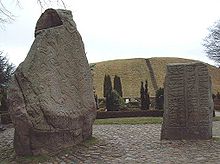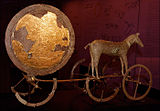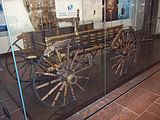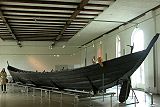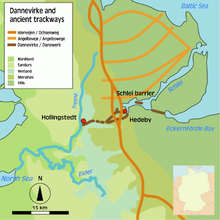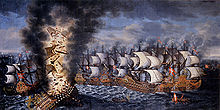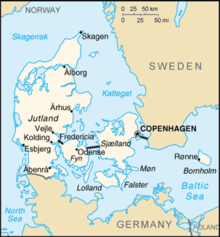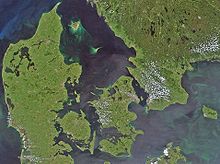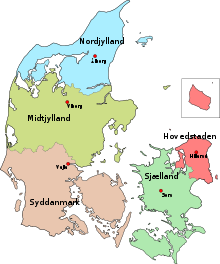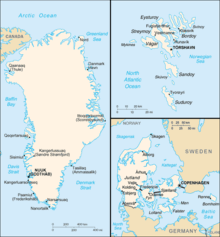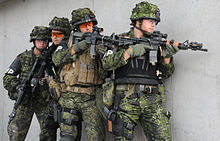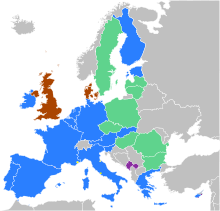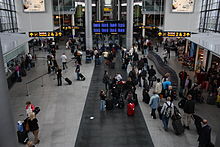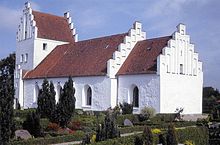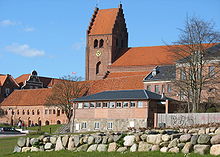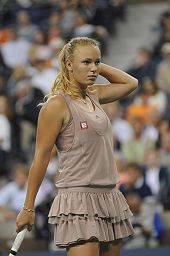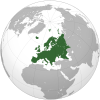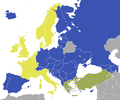- Denmark
-
This article is about the country. For other uses, see Denmark (disambiguation).
Denmark Danmark

Flag Coat of arms Motto: (Royal) "Guds hjælp, Folkets kærlighed, Danmarks styrke"1[1]
"God's Help, the People's Love, Denmark's Strength"Anthem: Der er et yndigt land (national)
Royal anthem: Kong Kristian stod ved højen mast (royal and national)Location of Denmark (dark green)– in Europe (green & dark grey)
– in the European Union (green) — [Legend]Capital
(and largest city)Copenhagen
55°43′N 12°34′E / 55.717°N 12.567°EOfficial language(s) Danish2 Ethnic groups (2010) 90.1% Danes,
9.9% others[2]Demonym Danish or Dane(s) Government Unitary parliamentary democracy and constitutional monarchy - Queen Margrethe II - Prime Minister Helle Thorning-Schmidt Legislature Folketing Consolidation 8th century Area - Total 43,075 km2 (132nd)
16,641 sq mi- Water (%) 1.64 Population - 2011 estimate 5,564,219[3] (110th) - Density 129/km2 (88th)
334/sq miGDP (PPP) 2010 estimate - Total $201.739 billion[4] - Per capita $36,449[4] GDP (nominal) 2010 estimate - Total $310.760 billion[4] - Per capita $56,147[4] Gini (2009) 24.7 (low) (1st) HDI (2010)  0.866[5] (very high) (19th)
0.866[5] (very high) (19th)Currency Danish krone ( DKK)Time zone CET (UTC+1) - Summer (DST) CEST (UTC+2) Drives on the right ISO 3166 code DK Internet TLD .dk3 Calling code 45 1Denmark has no civil national motto, however the motto "Guds hjælp, Folkets kærlighed, Danmarks styrke" was adopted by Queen Margrethe II as her personal, royal motto.
2German is recognised as a protected minority language in the South Jutland (Sønderjylland) area of Denmark.
3 The TLD .eu is shared with other European Union countries.Denmark
 i/ˈdɛnmɑrk/ (Danish: Danmark, pronounced [ˈdænmɑɡ̊] (
i/ˈdɛnmɑrk/ (Danish: Danmark, pronounced [ˈdænmɑɡ̊] ( listen)) is a Scandinavian country in Northern Europe. The countries of Denmark and Greenland, as well as the Faroe Islands, constitute the Kingdom of Denmark (Danish:
listen)) is a Scandinavian country in Northern Europe. The countries of Denmark and Greenland, as well as the Faroe Islands, constitute the Kingdom of Denmark (Danish:  Kongeriget Danmark (help·info)). It is the southernmost of the Nordic countries, southwest of Sweden and south of Norway, and bordered to the south by Germany. Denmark borders both the Baltic and the North Sea. The country consists of a large peninsula, Jutland (Jylland) and many islands, most notably Zealand (Sjælland), Funen (Fyn), Vendsyssel-Thy (commonly considered a part of Jutland), Lolland, Falster and Bornholm, as well as hundreds of minor islands often referred to as the Danish Archipelago. Denmark has long controlled the approach to the Baltic Sea (dominium maris baltici); before the digging of the Kiel Canal, water passage to the Baltic Sea was possible only through the three channels known as the "Danish straits".
Kongeriget Danmark (help·info)). It is the southernmost of the Nordic countries, southwest of Sweden and south of Norway, and bordered to the south by Germany. Denmark borders both the Baltic and the North Sea. The country consists of a large peninsula, Jutland (Jylland) and many islands, most notably Zealand (Sjælland), Funen (Fyn), Vendsyssel-Thy (commonly considered a part of Jutland), Lolland, Falster and Bornholm, as well as hundreds of minor islands often referred to as the Danish Archipelago. Denmark has long controlled the approach to the Baltic Sea (dominium maris baltici); before the digging of the Kiel Canal, water passage to the Baltic Sea was possible only through the three channels known as the "Danish straits".Denmark is a constitutional monarchy with a parliamentary system of government. It has a state-level government and local governments in 98 municipalities. Denmark has been a member of the European Union since 1973, although it has not joined the Eurozone. A founding member of NATO and the OECD, it is also a member of the Organisation for Security and Co-operation in Europe (OSCE).
Denmark, with a mixed market economy and a large welfare state,[6] ranks as having the world's highest level of income equality.[7] It has frequently ranked as the happiest[8][9] and least corrupt country in the world.[10] The national language, Danish, is closely related to Swedish and Norwegian, with which it shares strong cultural and historical ties.
Contents
Etymology
The etymology of the word Denmark, and especially the relationship between Danes and Denmark and the unifying of Denmark as a single kingdom, is a subject which attracts some debate.[11][12] The debate is centred primarily around the prefix "Dan" and whether it refers to the Dani or a historical person Dan and the exact meaning of the -"mark" ending. The issue is further complicated by a number of references to various Dani people in Scandinavia or other places in Europe in Greek and Roman accounts (like Ptolemy, Jordanes, and Gregory of Tours), as well as some mediaeval literature (like Adam of Bremen, Beowulf, Widsith and Poetic Edda).
Most handbooks derive[13] the first part of the word, and the name of the people, from a word meaning "flat land", related to German Tenne "threshing floor", English den "cave", Sanskrit dhánuṣ- (धनुस्; "desert"). The -mark is believed to mean woodland or borderland (see marches), with probable references to the border forests in south Schleswig,[14] maybe similar to Finnmark, Hedmark, Telemark or Dithmarschen.[citation needed]
In Norse, the land was called Danmǫrk.[15]
Some of the earliest descriptions of the origin of the word 'Denmark', describing a territory, are found in the Chronicon Lethrense (12th century), Svend Aagesen (late 12th century), Saxo Grammaticus (early 13th century) and the Ballad of Eric (mid 15th century). There are, however, many more Danish annuals and yearbooks containing various other details, similar tales in other variations, other names or spelling variations.
The Jelling Stones, commonly referred to as Denmark's "birth certificate", seen from the north with "Gorm's Mound" in the background
The Chronicon Lethrense explains that when the Roman Emperor Augustus went against Denmark in the time of David,[16] Denmark consisted of seven territories Jutland, Funen, Zealand, Møn, Falster, Lolland and Skåne which were governed by King Ypper of Uppsala. He had three sons, Nori, Østen and Dan. Dan was sent to govern Zealand, Møn, Falster, and Lolland, which became known jointly as Videslev. When the Jutes were fighting Emperor Augustus they called upon Dan to help them. Upon victory, they made him king of Jutland, Funen, Videslev and Skåne. A council decided to call this new united land Danmark (Dania) (English: Denmark) after their new king, Dan. Saxo relates that it is the legendary Danish King Dan, son of Humbli, who gave the name to the Danish people, though he does not expressly state that he is also the origin of the word "Denmark". Rather he tells that England ultimately derives its name from Dan’s brother Angel.
The earliest mention of a territory called "Denmark" is found in King Alfred the Great's modified translation into Old English of Paulus Orosius' Seven Books of History Against The Pagans ("Historiarum adversum Paganos Libri Septem"), written by Alfred when king of Wessex in the years 871–899. In a passage introduced to the text by Alfred, we read about Ohthere of Hålogaland’s travels in the Nordic region, during which 'Denmark [Denamearc] was on his port side... And then for two days he had on his (port side) the islands which belong to Denmark'.[17]
The first recorded use of the word "Denmark" within Denmark itself is found on the two Jelling stones, which are rune stones believed to have been erected by Gorm the Old (c. 955) and Harald Bluetooth (c. 965). The larger stone of the two is often cited as Denmark's birth certificate, though both use the word "Denmark", in the form of accusative ᛏᛅᚾᛘᛅᚢᚱᚴ "tanmaurk" ([danmɒrk]) on the large stone, and genitive "tanmarkar" (pronounced [danmarkaɽ]) on the small stone.[18] The inhabitants of Denmark are there called "tani" ([danɪ]), or "Danes", in the accusative. In the Song of Roland, estimated to have been written between 1040 and 1115, the first mention of the legendary Danish hero Holger Danske appears; he is mentioned several times as "Holger of Denmark" (Ogier de Denemarche).
History
Main article: History of DenmarkPrehistory
-
The gilded side of the Trundholm sun chariot
-
Copies of the Golden Horns of Gallehus at the National Museum of Denmark
-
The Nydam oak boat at Gottorp Castle, Schleswig, Germany
The earliest archaeological findings in Denmark date back to the Eem interglacial period from 130,000–110,000 BC.[19] Denmark has been inhabited since around 12,500 BC and agriculture has been evident since 3900 BC.[20] The Nordic Bronze Age (1800–600 BC) in Denmark was marked by burial mounds, which left an abundance of findings including lurs and the Sun Chariot.
During the Pre-Roman Iron Age (500 BC – 1 AD), native groups began migrating south, although[20] the first Danish people came to the country between the Pre-Roman and the Germanic Iron Age,[21] in the Roman Iron Age (1–400 AD). The Roman provinces maintained trade routes and relations with native tribes in Denmark, and Roman coins have been found in Denmark. Evidence of strong Celtic cultural influence dates from this period in Denmark and much of North-West Europe and is among other things reflected in the finding of the Gundestrup cauldron.
Historians believe that before the arrival of the precursors to the Danes, who came from the east Danish islands (Zealand) and Skåne and spoke an early form of North Germanic, most of Jutland and some islands were settled by Jutes. They were later invited to Great Britain as mercenaries by Brythonic King Vortigern and were granted the southeastern territories of Kent, the Isle of Wight among other areas, where they settled. They were later absorbed or ethnically cleansed by the invading Angles and Saxons, who formed the Anglo-Saxons. The remaining population in Jutland assimilated in with the Danes.
A short note[22] about the Dani in "Getica" by historian Jordanes is believed by some to be an early mention of the Danes,[23] one of the ethnic groups from whom the modern Danish people are descended. The Danevirke defence structures were built in phases from the 3rd century forward,[24] and the sheer size of the construction efforts in 737 are attributed to the emergence of a Danish king.[24] The new runic alphabet was first used around the same time, and Ribe, the oldest town of Denmark, was founded about 700.
Viking Age
Main article: Viking Age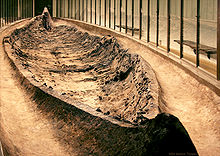 The Ladby ship, the largest ship burial found in Denmark
The Ladby ship, the largest ship burial found in Denmark
The Danish people were amongst those known as the Vikings during the 8th–11th centuries. Viking explorers first discovered and settled in Iceland in the 9th century, on their way from the Faroe Islands. From there, Greenland and Vinland (probably Newfoundland) were also settled. Utilizing their great skills in shipbuilding and navigation they raided and conquered parts of France and the British Isles. But they also excelled in trading along the coasts and rivers of Europe, running trade routes from Greenland in the north to Constantinople in the south via Russian rivers. The Danish Vikings were most active in Britain, Ireland, France, Spain, Portugal and Italy where they raided, conquered and settled (their earliest settlements included sites in the Danelaw, Ireland and Normandy).
In the early 9th century, Charlemagne's Christian empire had expanded to the southern border of the Danes, and Frankish sources (e.g. Notker of St Gall) provide the earliest historical evidence of the Danes. These report a King Gudfred, who appeared in present day Holstein with a navy in 804 where diplomacy took place with the Franks; In 808, King Gudfred attacked the Obotrite and conquered the city of Reric whose population was displaced or abducted to Hedeby. In 809, King Godfred and emissaries of Charlemagne failed to negotiate peace, despite the sister of Godfred being a concubine of Charlemagne, and the next year King Godfred attacked the Frisians with 200 ships.
The oldest parts of the defensive works of Danevirke near Hedeby at least date from the summer of 755 and were expanded with large works in the 10th century. The size and amount of troops needed to man it indicates a quite powerful ruler in the area, which might be consistent with the kings of the Frankish sources. In 815 AD, Emperor Louis the Pious attacked Jutland apparently in support of a contender to the throne, perhaps Harald Klak, but was turned back by the sons of Godfred, who most likely were the sons of the above mentioned Godfred. At the same time St. Ansgar travelled to Hedeby and started the Catholic Christianisation of Scandinavia.
The Danes were united and officially Christianised in 965 AD by Harald Bluetooth, the story of which is recorded on the Jelling stones. The extent of Harald's Danish Kingdom is unknown, although it is reasonable to believe that it stretched from the defensive line of Dannevirke, including the Viking city of Hedeby, across Jutland, the Danish isles and into southern present day Sweden; Scania and perhaps Halland and Blekinge. Furthermore, the Jelling stones attest that Harald had also "won" Norway. In retaliation for the St. Brice's Day massacre of Danes in England, the son of Harald, Sweyn Forkbeard mounted a series of wars of conquest against England, which was completed by Svend's son Cnut the Great by the middle of the 11th century.[25]
Following the death of Canute the Great, Denmark and England were divided. Sweyn Estridsen's son, Canute IV, raided England for the last time in 1085. He planned another invasion to take the throne of England from an aging William I. He called up a fleet of 1,000 Danish ships, 60 Norwegian long boats, with plans to meet with another 600 ships under Duke Robert of Flanders in the summer of 1086. Canute, however, was beginning to realise that the imposition of the tithe on Danish peasants and nobles to fund the expansion of monasteries and churches and a new head tax (Danish:nefgjald) had brought his people to the verge of rebellion. Canute took weeks to arrive at Struer where the fleet had assembled, but he found only the Norwegians still there.
Canute thanked the Norwegians for their patience and then went from assembly to assembly (Danish:landsting) outlawing any sailor, captain or soldier who refused to pay a fine which amounted to more than a years harvest for most farmers. Canute and his housecarls fled south with a growing army of rebels on his heels. Canute fled to the royal property outside the town of Odense on Funen with his two brothers. After several attempts to break in and then bloody hand to hand fighting in the church, Benedict was cut down and Canute struck in the head by a large stone and then speared from the front. He died at the base of the main altar 10 July 1086, where he was buried by the Benedictines. When Queen Edele came to take Canute's body to Flanders, a light allegedly shone around the church and it was taken as a sign that Canute should remain where he was.
The death of St. Canute marks the end of the Viking Age. Never again would massive flotillas of Scandinavians meet each year to ravage the rest of Christian Europe.
Medieval Denmark
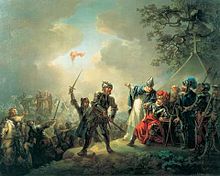 Dannebrog falling from the sky during the Battle of Lyndanisse, modern Tallinn, 15 June 1219. Painted by Christian August Lorentzen in 1809. Original located at Statens Museum for Kunst, Denmark
Dannebrog falling from the sky during the Battle of Lyndanisse, modern Tallinn, 15 June 1219. Painted by Christian August Lorentzen in 1809. Original located at Statens Museum for Kunst, Denmark
From the Viking age towards the end of the 13th century, the kingdom of Denmark consisted of Jutland, north from the Eider River, the islands of Zealand, Funen, and Bornholm, along with Skåne, Halland and Blekinge, which is a part of southern Sweden today. The lands between the Eider and the Kongeåen were separated from the kingdom as two vassal duchies of Schleswig and Holstein.
Following the end of the 11th century, Denmark underwent a transition from a patchwork of regional chiefs (Danish:jarls) with a weak and semi-elected royal institution, into a realm which more reflected European feudalism, with a powerful king ruling through an influential nobility. The period is marked by internal strife and the generally weak geopolitical position of the realm, which for long stretches fell under German influence. The period also featured the first of large stone buildings (mostly churches), a deep penetration by the Christian religion, the appearance of monastic orders in Denmark and the first written historical works such as the Gesta Danorum ("Deeds of the Danes"). German political as well as religious influence firmly ended in the last decades of the 12th century under the rule of King Valdemar the Great and his foster brother Absalon Hvide, Archbishop of Lund; through successful wars against Wend peoples of northeast Germany and the Holy Roman Empire.
 The tomb of Margaret I in Roskilde Cathedral
The tomb of Margaret I in Roskilde Cathedral
A high point was reached during the reign of Valdemar II, who led the formation of a Danish "Baltic Sea Empire", which by 1221 extended control from Estonia in the east to Norway in the north. In this period several of the "regional" law codes were given; notably the Code of Jutland from 1241, which asserted several modern concepts like right of property; "that the king cannot rule without and beyond the law"; "and that all men are equal to the law". Following the death of Valdemar II in 1241 and to the ascension of Valdemar IV in 1340, the kingdom was in general decline because of internal strife and the rise of the Hanseatic League. The competition between the sons of Valdemar II had the long term result that the southern parts of Jutland were separated from the kingdom of Denmark and became semi-independent vassal duchies/counties.
Kalmar Union
During the reign of Valdemar IV and his daughter Margaret I, the realm was re-invigorated; following the Battle of Falköping, Margaret I had her sister's son, Eric of Pomerania, crowned King of Denmark, Norway and Sweden after the signing of the union charter of Kalmar, Trinity Sunday 1397.[26] United under a single crown it was thought that the new kingdom would create a great power in the north.[27] The three countries were to be treated as equals in the union. However, even from the start Margaret may not have been so idealistic—treating Denmark as the clear "senior" partner of the union.[27] Thus, much of the next 125 years of Scandinavian history revolves around this union, with Sweden breaking off and being re-conquered repeatedly. The issue was for practical purposes resolved on 17 June 1523, as Swedish King Gustav Vasa conquered the city of Stockholm. Denmark and Norway, however, remained in a personal union until the Congress of Vienna in 1814.
Protestant Reformation
Main article: Reformation in Denmark-Norway and HolsteinThe Protestant Reformation came to Scandinavia in the 1520s. On Easter Sunday 1525, Hans Tausen, a monk in the Order of St John's Hospitalers, proclaimed aloud the need for Martin Luther's reforms in the Catholic Church. His sermon was the beginning of a ten year struggle which would change Denmark forever. Tausen was hustled off to a monastery in Viborg in northern Jutland where he would be isolated and away from Copenhagen and the court. Tausen simply preached through the window of his locked chamber. At first curious Danes came to hear the strange new ideas that Tausen was preaching. Within weeks Tausen was freed by his loyal followers, and then a Franciscan abbey church was broken open so Viborgers could hear God's word under a roof. Luther's ideas were accepted so rapidly that the local bishop and other churchmen in Viborg were unable to cope. In many churches the mass was celebrated alongside Lutheran sermons, and then Tausen's version of Luther's teachings began to spread to other parts of Jutland. Within a year Tausen was the personal chaplain of King Frederick I. Frederick tried to balance the old and new ideas insisting that they coexist; it lasted only as long as the king did.
A mob stormed Our Lady Church in Copenhagen in 1531 tearing down statues, destroying side altars, artwork and relics that had accumulated through its long history. Similar events happened through the country, although for the most part the change was peaceful. The majority of common people saw the reduced influence and wealth of the church as a liberating thing, but their new found influence did not last long.
At the death of Frederick I in 1533, two claimants to the throne – one backed by Protestant Lübeck and the other by Catholic nobles – caused a civil war known as the Count's Feud (Danish: Grevens Fejde) (1534–1536).[28] The massacre of Skipper Clement's peasant army at Aalborg in December 1534 brought an end to the war and left the pro-Lutheran party firmly in charge.[29] Denmark became officially Lutheran in 1536. Denmark's Catholic bishops were arrested and imprisoned. Abbeys, nunneries, monasteries and other church properties were confiscated by local nobility and the crown. Monks, nuns and clergy lost their livelihood. The bishops who agreed to marry and not stir up trouble were given former church lands as personal estates.[30]
Catholic influence remained longest in Viborg and the nearby area, where change permeated slowly, although the reformation originally began there.[31]
Modern history
For most of its history the attention of Denmark had been directed to the south. The Germans in the form of either the Hanseatic League or in the form of the rebellious minority population of the province of Slesvig had been demanding all the attention of the Danish Kingdom for centuries. However, by 1500, the Hanseatic League was in considerable decline.[32] The rise of the Dutch nation as a sea power and its unrestricted trade with Scandinavia broke the monopoly of the Hansa.[33] By 1614, 60% of all shipping passing through the sound between Denmark and Sweden was Dutch shipping.[34] The problem of Slesvig was not so much resolved as it was over-shadowed by a larger problem, the rising power of Sweden.[35]
Indeed, the religious Peace of Augsburg in 1555 served as a watershed in the history of Denmark.[36] Instead of looking south to Germany as a threat, Denmark began to look to the north—toward Sweden as a worse threat. Like Denmark, most of Northern Germany began to be deeply concerned about the military threat posed by a strong Sweden. Thus, the various German states began to worry less about supporting the German minority population in Slesvig and began to concentrate on the Swedish threat. Accordingly, Denmark was free to turn her attentions to Sweden as well.
After Sweden permanently broke away from the Kalmar Union in 1523, Denmark tried on two occasions to reassert control over Sweden. The first was in the Northern Seven Years War which lasted from 1563 until 1570. The second occasion was the Kalmar War when King Christian IV attacked Sweden in 1611 but failed to accomplish his main objective of forcing Sweden to return to the union with Denmark. The war led to no territorial changes, but Sweden was forced to pay a war indemnity of 1 million silver riksdaler to Denmark, an amount known as the Älvsborg ransom.[37]
 Danish Infantry regiment in a fight with regiment "Martini". Contemporary illustration of the 1864 Second Schleswig War.
Danish Infantry regiment in a fight with regiment "Martini". Contemporary illustration of the 1864 Second Schleswig War.
King Christian used this money to found several towns and fortresses, most notably Glückstadt (founded as a rival to Hamburg), Christiania (following a fire destroying the original city of Oslo), Christianshavn, Christianstad and Christiansand. Christian also constructed a number of buildings, most notably Børsen, Rundetårn, Nyboder, Rosenborg, a silver mine and a copper mill. Inspired by the Dutch East India Company, he founded a similar Danish company and planned to claim Ceylon as a colony, but the company only managed to acquire Tranquebar on India's Coromandel Coast.
In the Thirty Years' War, Christian tried to become the leader of the Lutheran states in Germany but suffered a crushing defeat at the Battle of Lutter.[38] The result was that the Catholic army under Albrecht von Wallenstein was able to invade, occupy and pillage Jutland,[39] forcing Denmark to withdraw from the war. Denmark managed to avoid territorial concessions, but Gustavus Adolphus' intervention in Germany was seen as a sign that the military power of Sweden was on the rise while Denmark's influence in the region was declining. Swedish armies invaded Jutland in 1643 and claimed Skåne in 1644. According to Geoffrey Parker, "The Swedish occupation caused a drop in agricultural production and a shortage of capital; harvest failure and plague ravaged the land between 1647 and 1651; Denmark's population fell by 20 per cent."[40]
In the 1645 Treaty of Brømsebro, Denmark surrendered Halland, Gotland, the last parts of Danish Estonia, and several provinces in Norway. In 1657, King Frederick III declared war on Sweden and marched on Bremen-Verden. This led to a massive Danish defeat, and the armies of King Charles X Gustav of Sweden conquered Jutland, Funen and much of Zealand before signing the Peace of Roskilde in February 1658 which gave Sweden control of Skåne, Blekinge, Trøndelag and the island of Bornholm. Charles X Gustav quickly regretted not having destroyed Denmark completely; in August 1658 he began a two-year long siege of Copenhagen but failed to take the capital. In the following peace settlement, Denmark managed to maintain its independence and regain control of Trøndelag and Bornholm.
 Den Grundlovgivende Rigsforsamling
Den Grundlovgivende Rigsforsamling
The Constitutional Assembly created The Danish constitution, 1860–1864 painting by Constantin HansenDenmark tried to regain control of Scania in the Scanian War (1675–79), but it ended in failure. Following the Great Northern War (1700–21), Denmark managed to restore control of the parts of Schleswig and Holstein ruled by the house of Holstein-Gottorp in 1721 and 1773, respectively. Denmark prospered greatly in the last decades of the 18th century because its neutral status allowed it to trade with both sides in the many contemporary wars. In the Napoleonic Wars, Denmark originally tried to pursue a policy of neutrality to continue the lucrative trade with both France and Great Britain and joined the League of Armed Neutrality with Russia, Sweden and Prussia.
The British considered this a hostile act and attacked Copenhagen in both 1801 and 1807, in one case carrying off the Danish fleet and burning large parts of the Danish capital. These events mark the end of the prosperous Florissant Age and resulted in the Dano-British Gunboat War. British control over the waterways between Denmark and Norway proved disastrous to the union's economy; in 1813 Denmark-Norway went bankrupt.
The post-Napoleonic Congress of Vienna demanded the dissolution of the Dano-Norwegian union, and this was confirmed by the Treaty of Kiel in 1814. Denmark-Norway had briefly hoped to restore the Scandinavian union in 1809, but these hopes were dashed when the estates of Sweden rejected a proposal to let Frederick VI of Denmark succeed the deposed Gustav IV Adolf and instead gave the crown to Charles XIII. Norway entered a new union with Sweden which lasted until 1905. Denmark kept the colonies of Iceland, the Faroe Islands and Greenland. Apart from the Nordic colonies, Denmark ruled over Danish India from 1620 to 1869, the Danish Gold Coast from 1658 to 1850, and the Danish West Indies from 1671 to 1917.
The Danish liberal and national movement gained momentum in the 1830s, and after the European Revolutions of 1848 Denmark peacefully became a constitutional monarchy on 5 June 1849. After the Second War of Schleswig (Danish: Slesvig) in 1864, Denmark was forced to cede Schleswig and Holstein to Prussia, in a defeat that left deep marks on the Danish national identity. After these events, Denmark returned to its traditional policy of neutrality, also keeping Denmark neutral in World War I.
20th and 21st centuries
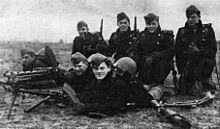 A group of Danish soldiers on the morning of the German invasion, 9 April 1940.[41]
A group of Danish soldiers on the morning of the German invasion, 9 April 1940.[41]
 Denmark became a member of the European Union in 1973 and signed the Lisbon Treaty in 2007.
Denmark became a member of the European Union in 1973 and signed the Lisbon Treaty in 2007.
Following the defeat of Germany, the Versailles powers offered to return the region of Schleswig-Holstein to Denmark. Fearing German irredentism, Denmark refused to consider the return of the area and insisted on a plebiscite concerning the return of Schleswig. The two Schleswig Plebiscites took place on 10 February and 14 March 1920, respectively. On 10 July 1920 after the plebiscite and the king's signature (6 July) on the reunion document, King Christian X rode across the old border on a white horse, and Northern Schleswig (Sønderjylland) was recovered by Denmark, thereby adding 163,600 inhabitants and 3,984 km². The reunion day (Genforeningsdag) is celebrated every year on Valdemarsdag, 15 June.
Germany's invasion of Denmark on 9 April 1940 – code named Operation Weserübung – met only two hours of military resistance before the Danish government surrendered. Economic co-operation between Germany and Denmark continued until 1943, when the Danish government refused further co-operation and its navy sank most of its ships and sent as many of their officers as they could to neutral Sweden. During the war, the government was helpful towards the Danish Jewish minority, and the Danish resistance performed a rescue operation that managed to get most of them to Sweden and safety shortly before the Germans planned to round up the Danish Jews. Denmark also stopped most captured Jews and political prisoners from being sent to German camps by paying and supplying one in Denmark that had far better chances of survival for the prisoners. Denmark led many "inside operations" or sabotage against the German facilities. In 1944 Iceland severed ties to Denmark and became an independent republic, and in 1948 the Faroe Islands gained home rule.
After the war, Denmark became one of the founding members of the United Nations and NATO, and in 1973, along with Britain and Ireland, joined the European Economic Community (now the European Union) after a public referendum. The Maastricht treaty was ratified after a further referendum in 1993 and the subsequent addition of concessions for Denmark under the Edinburgh Agreement. Greenland gained home rule in 1979 and was awarded self-determination in 2009. Neither Greenland nor the Faroe Islands are members of the European Union, the Faroese declining membership in EEC from 1973 and Greenland from 1986, in both cases because of fisheries policies.
Despite its modest size, Denmark has been participating in major UN sanctioned, and often NATO led, military and humanitarian operations notably including: Cyprus, Bosnia and Herzegovina, Korea, Egypt, Croatia, Kosovo, Ethiopia, Afghanistan, Iraq, Somalia and recently Libya. In 2009 Anders Fogh Rasmussen resigned as Prime Minister of Denmark to become the Secretary General of NATO.
Geography
Main article: Geography of Denmark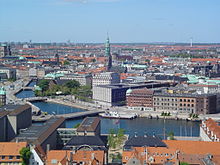 Copenhagen, the capital of Denmark
Copenhagen, the capital of Denmark
Denmark shares a border of 68 kilometres with Germany to the south and is otherwise surrounded by 7,314 kilometres of tidal shoreline (including small bays and inlets). It occupies 43,094 square kilometres. Since 2000 Denmark has been connected by the Øresund Bridge to southern Sweden.
Denmark's northernmost point is Skagens point (the north beach of the Skaw) at 57° 45' 7" northern latitude; the southernmost is Gedser point (the southern tip of Falster) at 54° 33' 35" northern latitude; the westernmost point is Blåvandshuk at 8° 4' 22" eastern longitude; and the easternmost point is Østerskær at 15° 11' 55" eastern longitude. This is in the archipelago Ertholmene 18 kilometres northeast of Bornholm. The distance from east to west is 452 kilometres (281 mi), from north to south 368 kilometres (229 mi).
Denmark consists of the peninsula of Jutland (Jylland) and 443 named islands (1,419 islands above 100 m² in total).[42] Of these, 72 are inhabited,[43] with the largest being Zealand (Sjælland) and Funen (Fyn). The island of Bornholm is located east of the rest of the country, in the Baltic Sea. Many of the larger islands are connected by bridges; the Øresund Bridge connects Zealand with Sweden; the Great Belt Bridge connects Funen with Zealand; and the Little Belt Bridge connects Jutland with Funen. Ferries or small aircraft connect to the smaller islands. Main cities are the capital Copenhagen on Zealand; Århus, Aalborg and Esbjerg in Jutland; and Odense on Funen.
The country is flat with little elevation; having an average height above sea level of 31 metres (102 ft). The highest natural point is Møllehøj, at 170.86 metres (560.56 ft). Other hills in the same area southwest of Århus are Yding Skovhøj at 170.77 metres (560.27 ft) and Ejer Bavnehøj at 170.35 metres (558.89 ft).[44] The area of inland water is: (eastern Denmark) 210 km2 (81 sq mi); (western D.) 490 km2 (189 sq mi).
Denmark's tidal shoreline is 7,314 km (4,545 mi).[45] No location in Denmark is further from the coast than 52 km (32 mi). The size of the land area of Denmark cannot be stated exactly since the ocean constantly erodes and adds material to the coastline, and because of human land reclamation projects (to counter erosion). On the southwest coast of Jutland, the tide is between 1 and 2 m (3.28 and 6.56 ft), and the tideline moves outward and inward on a 10 km (6.2 mi) stretch.[46]
Phytogeographically, Denmark (including Greenland and the Faroe Islands) belongs to the Boreal Kingdom and is shared between the Arctic, Atlantic European and Central European provinces of the Circumboreal Region. According to the World Wide Fund for Nature, the territory of Denmark can be subdivided into two ecoregions: the Atlantic mixed forests and Baltic mixed forests. The Faroe Islands are covered by the Faroe Islands boreal grasslands, while Greenland hosts the ecoregions of Kalaallit Nunaat high arctic tundra and Kalaallit Nunaat low arctic tundra.
Climate
The climate is in the temperate zone. The winters are not particularly cold, with mean temperatures in January and February of 0.0 °C, and the summers are cool, with a mean temperature in August of 15.7 °C.[47] Denmark has an average of 121 days per year with precipitation, on average receiving a total of 712 mm per year; autumn is the wettest season and spring the driest.[47]
Because of Denmark's northern location, the length of the day with sunlight varies greatly. There are short days during the winter with sunrise coming around 8:45 am and sunset 3:45 pm, as well as long summer days with sunrise at 4:30 am and sunset at 10 pm[48] Christmas (Danish: jul), is celebrated on Christmas Eve, 24 December. The celebration for the longest day is known in Denmark as St. Hans Aften (St. John's evening).[49] Celebrations of Midsummer have taken place since pre-Christian times.[50]
Environment
Denmark has historically taken a progressive stance on environmental preservation; in 1971 Denmark established a Ministry of Environment and was the first country in the world to implement an environmental law in 1973.
To mitigate environmental degradation and global warming the Danish Government has signed the following international agreements: Antarctic Treaty; Climate Change-Kyoto Protocol; Endangered Species Act[51] These agreements have helped in the reduction in CO2 emissions by Denmark.
Denmark was ranked as the 10th best country in the world for "Living Green" by a 2007 Readers Digest survey,[52] and Copenhagen is recognised as one of the most environmentally friendly cities in the world.[53] Much of the city's success can be attributed to a strong municipal policy combined with a sound national policy; in 2006 Copenhagen Municipality received the European Environmental Management Award.[54] The award was given for long-term holistic environmental planning. Recently many of Denmark's smaller Municipalities such as Lolland and Bornholm have also become environmental leaders. Denmark is home to five of the world's ten largest central solar heating plants (CSHP). The world's largest CSHP is situated in the small community of Marstal on the island of Ærø.
Copenhagen is the spearhead of the bright green environmental movement in Denmark. In 2008, Copenhagen was mentioned by Clean Edge as one of the key cleantech clusters to watch in the book The Cleantech Revolution. The city is the focal point for more than half of Denmark's 700 cleantech companies and draws on some 46 research institutions. The cluster employs more than 60,000 people and is characterised by a close collaboration between universities, business and governing institutions. The capital's most important cleantech research institutions are the University of Copenhagen, Copenhagen Business School,[55] Risø DTU National Laboratory for Sustainable Energy and the Technical University of Denmark which Risø is now part of. Leading up to the 2009 United Nations Climate Change Conference the University of Copenhagen held the Climate Change: Global Risks, Challenges and Decisions conference where the need for comprehensive action to mitigate climate change was stressed by the international scientific community. Notable figures such as Rajendra K. Pachauri, Chairman of the IPCC, Professor Nicholas Stern, author of the Stern Report and Professor Daniel Kammen all emphasised the good example set by Copenhagen and Denmark in capitalising on cleantech and achieving economic growth while stabilising carbon emissions.
Denmark's green house gas emissions per dollar of value produced has been for the most part unstable since 1990, seeing sudden growths and falls. Overall though, there has been a reduction in gas emissions per dollar value added to its market.[56] It is comparable to countries such as Germany,[57] but lagging behind other Scandinavian countries such as Norway[58] and Sweden.[59]
Administrative divisions
Main articles: Regions of Denmark and Municipalities of Denmark- For the administrative divisions used until 2006, see Counties of Denmark.
Denmark is divided into five regions (Danish: regioner, singular: region) and a total of 98 municipalities. The regions were created on 1 January 2007 as part of the 2007 Danish Municipal Reform to replace the country's traditional thirteen counties (amter). At the same time, smaller municipalities (kommuner) were merged into larger units, cutting the number of municipalities from 270 to 98. Most municipalities have a population of at least 20,000 people to give them financial and professional sustainability, although a few exceptions were made to this rule.
The most important area of responsibility for regions is the national health service. Unlike the former counties, the regions are not allowed to levy taxes, and the health service is primarily financed by a national 8% (sundhedsbidrag) tax combined with funds from both government and municipalities. Each Regional Council consists of 41 elected politicians elected as part of the 2005 Danish municipal elections.
The Ertholmene archipelago (96 inhabitants (2008)) is neither part of a municipality nor a region but belongs to the Ministry of Defence.[60]
Danish name English name Seat of administration Largest city Population
(1 January 2008)Area
(km²)Pop. density
(per km²)Region Hovedstaden Capital Region of Denmark Hillerød Copenhagen 1,645,825 2,561 642.6 Region Midtjylland Central Denmark Region Viborg Århus 1,237,041 13,142 94.2 Region Nordjylland North Denmark Region Aalborg Aalborg 578,839 7,927 73.2 Region Sjælland Region Zealand Sorø Roskilde 819,427 7,273 112.7 Region Syddanmark Region of Southern Denmark Vejle Odense 1,194,659 12,191 97.99 Entire country 5,475,791 43,094 127.0 | Greenland and the Faroe Islands have autonomous status within the Danish Realm and are largely self-governing; They are represented by two seats in the parliament each.
Country Population
(2011 estimate)Area
(km²)Density
(pop per km²) Denmark
Denmark5,564,219 43,075 129  Faroe Islands
Faroe Islands49,267 1,399 35  Greenland
Greenland56,615 2,166,086 0.027  Kingdom of Denmark
Kingdom of Denmark5,670,101 2,220,097 2.6 Politics
Main articles: Politics of Denmark and Government of Denmark Queen Margrethe II of Denmark.
Queen Margrethe II of Denmark.
The Kingdom of Denmark is a constitutional monarchy. The current and reigning monarch is Queen Margrethe II. As stipulated in the Danish Constitution, the monarch is not answerable for their actions, and their person is sacrosanct. The monarch formally appoints and dismisses the prime minister and other ministers. The prime minister is customarily chosen through negotiation between the parliament party leaders.
Before being validated through royal assent, all bills and important government measures must be discussed in Statsrådet, a privy council headed by the monarch. The Danish privy council's protocols are secret. Although the monarch is formally given executive power this power is strictly ceremonial. The monarch is expected to be entirely apolitical and refrain from influencing the government.[61] For example, members of the royal family do not cast their votes in elections and referendums even though they have the right.
Legislative authority is vested in the executive (prime minister) and the Danish parliament conjointly. Judicial authority lies with the courts of justice.[62]
Executive authority is exercised on behalf of the monarch by the prime minister and other cabinet ministers who head departments. The cabinet, prime minister and other ministers collectively make up the government. These ministers are responsible to Folketinget (the Danish Parliament), the legislative body, which is traditionally considered to be supreme (that is, able to legislate on any matter and not bound by decisions of its predecessors).
The Folketing is the national legislature. It has the ultimate legislative authority according to the doctrine of parliamentary sovereignty, however questions over sovereignty have been brought forward because of Denmark’s entry into the European Union. In theory the doctrine prevails. Parliament consists of 175 members elected by proportional majority, plus two members each from Greenland and Faroe Islands.[63] Parliamentary elections are held at least every four years, but it is within the powers of the prime minister to ask the monarch to call for an election before the term has elapsed. On a vote of no confidence, the parliament may force a single minister or the entire government to resign.
The Danish political system has traditionally generated coalitions. Most Danish post-war governments have been minority coalitions ruling with the support of non-government parties.[64]
Anders Fogh Rasmussen from the Venstre party, a center-right liberal party was prime minister from November 2001 to April 2009. His government was a coalition consisting of Venstre and the Conservative People's Party, with parliamentary support from the national-conservative Danish People's Party (Dansk Folkeparti). The three parties obtained a parliamentary majority in the 2001 election and maintained it virtually unchanged in the 2005 election. On 24 October 2007, an early election was called by the Prime Minister for 13 November. Following the election the Danish People's Party was strengthened while Anders Fogh Rasmussen's Venstre lost 6 seats and the Conservative People's Party retained the same number of seats in Parliament as prior to the election. The result ensured that Anders Fogh Rasmussen could continue as prime minister for a third term.
From the autumn of 2008 rumours persisted that Anders Fogh Rasmussen aspired to head NATO. On 4 April 2009, during a NATO summit in Strasbourg, Rasmussen confirmed these speculations. Opposition within NATO, especially from Turkey, was overcome, and Rasmussen was appointed Secretary General of NATO. On 5 April 2009, Rasmussen resigned, leaving minister of finance and vice president of Venstre Lars Løkke Rasmussen to be the prime minister.
With the parliamentary election held September 2011 the right wing coalition known as blue bloc, lost by a small margin to the opposing coalition, lead by Helle Thorning-Schmidt who on 3 October 2011 formed a new government consisting of the Social Democratic Party, Danish Social Liberal Party and Socialist People's Party.
Foreign relations
Main article: Foreign relations of DenmarkDanish foreign policy is based on its identity as a sovereign nation in Europe. As such its primary foreign policy focus is on its relations with other nations as a sovereign independent nation. Denmark has long had good relations with other nations. It has been involved in coordinating Western assistance to the Baltic states (Estonia,[65] Latvia, and Lithuania).[66] The country is a strong supporter of international peacekeeping.
Denmark is today pursuing an active foreign policy, where human rights, democracy and other crucial values are to be defended actively. In recent years Greenland and The Faroe Islands have been guaranteed a say in foreign policy issues such as fishing, whaling, and geopolitical concerns.
Military
Main articles: Danish Defence and Military history of DenmarkDenmark's armed forces are known as the Danish Defence (Danish: Forsvaret). During peacetime, the Ministry of Defence in Denmark employs around 33,000 in total. The main military branches employ almost 27,000: 15,460 in the Royal Danish Army, 5,300 in the Royal Danish Navy and 6,050 in the Royal Danish Air Force (all including conscripts).
The Danish Emergency Management Agency (Danish: Beredskabsstyrelsen) employs 2,000 (including conscripts), and about 4,000 are in non-branch-specific services like the Danish Defence Command, the Danish Defence Research Establishment and the Danish Defence Intelligence Service. Furthermore around 55,000 serve as volunteers in the Danish Home Guard (Danish: Hjemmeværnet).
The Danish Defence has around 1,400[67] staff in international missions, not including standing contributions to NATO SNMCMG1. The three largest contributions are in Afghanistan (ISAF), Kosovo (KFOR) and Lebanon (UNIFIL). Between 2003 and 2007, there were approximately 450 Danish soldiers in Iraq.[68]
Economy
Main article: Economy of DenmarkDenmark's mixed economy features above average European living standards[69][70] and high amount of free trade. Denmark ranks 16th in the world in terms of GDP (PPP) per capita and ranks 5th in nominal GDP per capita.
According to World Bank Group, Denmark has the most flexible labour market in Europe; the policy is called flexicurity. It is easy to hire and fire (flexibility), and between jobs, unemployment compensation is very high (security). Denmark has a labour force of about 2.9 million. Denmark has the fourth highest ratio of tertiary degree holders in the world.[71] GDP per hour worked was the 13th highest in 2009. Denmark has the world's lowest level of income inequality, according to the UN, and the world's highest minimum wage, according to the IMF. As of June 2010 the unemployment rate is at 6.6%, which is below the EU average of 9.6%.[72]
Denmark is one of the most competitive economies in the world according to World Economic Forum 2008 report, IMD and The Economist.[73] According to rankings by OECD, Denmark has the most free financial markets in EU-15 and also one of the most free product markets.
Denmark has a company tax rate of 25% and a special time limited tax regime for expatriates.[74] The Danish taxation system is broad based, with a 25% VAT, in addition to excise taxes, income taxes and other fees. The overall tax burden (sum of all taxes, as a percentage of GDP) is estimated to be 46% in 2011.[75]
Denmark's national currency, the krone (plural: kroner), is de facto linked to the Euro through the ERM.[76] The exchange rate is pegged at approximately 7.46 kroner per euro. While Denmark in a September 2000 referendum rejected replacing the Danish kroner with the euro, the country in practice follows the policies set forth in the Economic and Monetary Union of the European Union (EMU) and meets the economic convergence criteria for participating in the third phase (the Euro) of the EMU. The majority of the political parties in the parliament are for the Euro, but as yet a new referendum has not been held, despite plans;[77] skepticism of the EU among Danish voters has historically been strong.
Denmark is known for the Danish cooperative movement within among others farming, the food industry (Danish Crown), dairy production (Arla Foods), retailing (Brugsen), wind turbine cooperatives and co-housing associations.
Support for free trade is high – in a 2007 poll 76% responded that globalisation is a good thing.[78] 70% of trade flows are inside the European Union. Denmark has the 9th highest export per capita in the world. Main exports include: machinery, animals and foodstuffs, chemicals and oil and gas.[79] Denmark is a net exporter of food and energy and has for a number of years had a balance of payments surplus while battling an equivalent of approximately 39% of GNP foreign debt or more than 300 billion DKK.[80] Also of importance is the sea territory of more than 105,000 km² (40,000+ sq mi).
Denmark has ranked as the world's 11th most free economy, of 162 countries, in an index created by the Wall Street Journal and Heritage Foundation, the Index of Economic Freedom 2008. The Index has been categorised as using inappropriately weighted indicators for economic freedom, leading to wealthy and/or conservative countries with barriers to trade placing high on the list, while poor and/or socialist countries with fewer restrictions on trade place low.[81] The Index has only a 10% statistical correlation with a standard measure of economic growth at GDP per capita.[82] Neither does the Index account for the actions of governments to nurture business[83] in the manner of the Japanese Zaibatsus during the late 20th century that helped lead to the Japanese economic miracle.
StatBank is the name of a large statistical database maintained by the central authority of statistics in Denmark. Online distribution of statistics has been a part of the dissemination strategy in Denmark since 1985. By this service, Denmark is a leading country in the world regarding electronic dissemination of statistics. There are about 2 million hits every year.
Energy
 Offshore wind turbines near Copenhagen
Offshore wind turbines near Copenhagen Main article: Energy in Denmark
Main article: Energy in DenmarkDenmark has considerable sources of oil and natural gas in the North Sea and ranks as number 32 in the world among net exporters of crude oil.[84] Most electricity is produced from coal, but Denmark also has a share of wind power. Wind turbines produce 16–19% of electricity demand.[85] Denmark is connected by transmission lines to other European countries.
Denmark is a long time leader in wind energy, and as of May 2011[update] Denmark derives 3.1 percent of its Gross Domestic Product from renewable (Clean) energy technology and energy efficiency, or around €6.5 billion ($9.4 billion).[86]
Transport
Main article: Transport in DenmarkCopenhagen Airport is the 15th busiest airport in Europe.
Significant investment has been made in building road and rail links between regions in Denmark, most notably the Great Belt Fixed Link, which connects Zealand and Funen. It is now possible to drive from Frederikshavn in northern Jutland to Copenhagen on eastern Zealand without leaving the motorway. The main railway operator is DSB for passenger services and DB Schenker Rail for freight trains. The railway tracks are maintained by Banedanmark. Copenhagen has a small Metro system, the Copenhagen Metro, and the greater Copenhagen area has an extensive electrified suburban railway network, the S-train. Denmark's national airline (together with Norway and Sweden) is Scandinavian Airlines (SAS), and Copenhagen Airport is the largest in Scandinavia. A ferry link to the Faroe Islands is maintained by Smyril Line. Other international ferry services are mainly operated by DFDS (to Norway and the UK), Scandlines (to Germany and Sweden), Stena Line (to Norway, Sweden, and Poland), Color Line (to Norway), and FjordLine (to Norway).
Private vehicles are increasingly used as a means of transport. Because of the high registration tax (180%), VAT (25%), and the world's highest income tax rate, new cars are very expensive. The purpose of the tax is to discourage car ownership. The car fleet has increased by 45% over the last 30 years. In 2007 an attempt was made by the government to favour environmentally-friendly cars by slightly reducing taxes on high mileage vehicles. However, this has had little effect, and in 2008 Denmark experienced an increase in the import of fuel inefficient old cars (mostly older than 10 years),[87] primarily from Germany, as the cost for older cars—including taxes—keeps them within the budget of many Danes.
Bicycling in Denmark is a common form of transportation, particularly for the young and for city dwellers. With a network of bicycle routes extending more than 12,000 km[88] and an estimated 7,000 km[89] of segregated dedicated bicycle paths and lanes, Denmark has a solid bicycle infrastructure.
Denmark has integrated fluctuating and unpredictable energy sources such as wind power into the grid. Denmark now aims to focus on intelligent battery systems (V2G) and plug-in vehicles in the transport sector.[90][91]
Public policy
See also: Nordic model and FlexicurityAfter deregulating the labour market in the 1990s, Denmark has one of the most free labour markets in European countries. According to World Bank labour market rankings, the labour market flexibility is at the same levels as the United States. Around 80% of employees belong to unions and the unemployment funds that are attached to them. Labour market policies is mainly determined in negotiations between the workers' unions and employers' unions, and the government only interferes if labour strikes extend for too long.
Despite the success of the trade unions, a growing number of people make contracts individually rather than collectively, and many (four out of ten employees) are contemplating dropping especially unemployment fund but occasionally even union membership altogether. The average employee receives a benefit at 47% of their wage level if they have to claim benefits when unemployed. With low unemployment, very few expect to be claiming benefits at all. The only reason then to pay the earmarked money to the unemployment fund would be to retire early and receive early retirement pay (efterløn), which is possible from the age of 60 provided an additional earmarked contribution is paid to the unemployment fund.[92]
The unemployment rate for December 2007 was 2.7%, for a total of 74,900 persons, a reduction by 112,800 persons—2,400 per month—or 60% since December 2003.[93] The Eurostat unemployment number for August 2008 is 2.9%. This has been achieved by employing more than 38% (800,000 people)[94] of the total workforce in public sector jobs. Another measure of the situation on the labour market is the employment rate, that is the percentage of people aged 15 to 64 in employment out of the total number of people aged 15 to 64. The employment rate for Denmark in 2007 was 77.1% according to Eurostat. Of all countries in the world, only Switzerland with 78.% and Iceland with 85.1% had a higher employment rate.
In December 2008, Statistics Denmark reported that 100,000 Danes were affected by unemployment in the third quarter of 2008. Of these, 62% received a job within two months, and 6% had been unemployed for two years or more.
The number of unemployed is forecast to be 65,000 in 2015. The number of people in the working age group, less disability pensioners etc., will grow by 10,000 to 2,860,000, and jobs by 70,000 to 2,790,000;[95] part time jobs are included.[96] Because of the present high demand and short supply of skilled labour, for instance for factory and service jobs, including hospital nurses and physicians, the annual average working hours have risen, especially compared with the recession 1987–1993.[97] Increasingly, service workers of all kinds are in demand, i.e. in the postal services and as bus drivers, and academics.[98] In the fall of 2007, more than 250,000 foreigners are working in the country, of which 23,000 still reside in Germany or Sweden.[99] According to a sampling survey of over 14,000 enterprises from December 2007 to April 2008 39,000 jobs were not filled, a number much lower than earlier surveys, confirming a downturn in the economic cycle.[100]
The level of unemployment benefits is dependent on former employment (the maximum benefit is at 90% of the wage) and at times also on membership of an unemployment fund, which is almost always—but need not be—administered by a trade union, and the previous payment of contributions. However, the largest share of the financing is still carried by the central government and is financed by general taxation, and only to a minor degree from earmarked contributions. There is no taxation, however, on proceeds gained from selling one´s home (provided there was any home equity (da:friværdi)), as the marginal tax rate on capital income from housing savings is around 0%.[101]
The Danish welfare model is accompanied by a taxation system that is both broad based (25% VAT, not including excise, duty and tax) and with a progressive income tax model, meaning the more money that is earned, the higher income tax percentage that gets paid (minimum tax rate for adults is 42% scaling to over 60%, except for the residents of Ertholmene that escape the otherwise ubiquitous 8% healthcare tax fraction of the income taxes[102][103]). Other taxes include the registration tax on private vehicles, at a rate of 180%, on top of VAT. Lately (July 2007) this has been changed slightly in an attempt to favour more fuel efficient cars but maintaining the average taxation level more or less unchanged.[104]
Demographics
Main articles: Demographics of Denmark and Languages of Denmark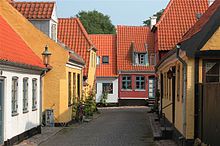 Ærøskøbing, a traditional Danish town
Ærøskøbing, a traditional Danish town
According to 2009 figures from Statistics Denmark, 90.5% of Denmark’s population of over 5.4 million was of Danish descent.[2] Many of the remaining 9.5% were immigrants—or descendants of recent immigrants—from Bosnia and Herzegovina, neighbouring countries, South Asia, and Western Asia. Many have arrived since the "Alien law" (Udlændingeloven) was enacted in 1983, which allows for the immigration of family members of those who had already arrived. There are also small groups of Inuit from Greenland and Faroese.During recent years, anti mass-immigration sentiment has resulted in some of the toughest immigration laws in the European Union.[105][106] The number of residence permits granted related to labour and to people from within the EU/EEA has increased since implementation of new immigration laws in 2001. The number of immigrants allowed into Denmark for family reunification decreased 70% between 2001 and 2006 to 4,198.(see 24 year rule) During the same period the number of asylum permits granted has decreased by 82.5% to 1,095, reflecting a 84% decrease in asylum seekers to 1,960.[107]
Denmark’s population is 5,475,791, giving Denmark a population density of 129.16 inhabitants per km² (334.53 per sq mi).[108] As in most countries, the population is not distributed evenly. Although the land area east of the Great Belt only makes up 9,622 km2 (3,715 sq mi), 22.7% of Denmark's land area, it has 45% (2,465,348) of the population. The average population density of this area is 256.2 inhabitants per km² (663.6 per sq mi). The average density in the west of the country (32,772 km²/12,653 sq mi) is 91.86/km² (237.91 per sq mi) (3,010,443 people) (2008).
The median age is 39.8 years, with 0.98 males per female. 98.2% of the population (age 15 and up) is literate. The birth rate is 1.74 children born per woman (2006 est.). Despite the low birth rate, the population is still growing at an average annual rate of 0.33%.[51] An international study conducted by Adrian White at Leicester University in 2006 showed that the population of Denmark had the highest life satisfaction in the world.[109]
Danish is the official language and is spoken throughout the country. English and German are the most widely-spoken foreign languages.
A total of 1,516,126 Americans reported Danish ancestry in the 2006 American Community Survey.[110] According to the 2006 census, there were 200,035 Canadians with Danish background.[111]
Religion
Main article: Religion in DenmarkChurch of Denmark year population members percentage 1984 5,113,500 4,684,060 91.6% 1990 5,135,409 4,584,450 89.3% 2000 5,330,500 4,536,422 85.1% 2005 5,413,600 4,498,703 83.3% 2007 5,447,100 4,499,343 82.6% 2008 5,475,791 4,494,589 82.1% 2009 5,511,451 4,492,121 81.5% 2010 5,534,738 4,479,214 80.9% 2011 5.560.628 4,469,109 80.4% statistical data 1984–2002,[112] 1990–2009[113] and 2010-2011.[114] Source Kirkeministeriet According to official statistics from January 2011, 80.4%[115] of the population of Denmark are members of the Danish National Church (Den Danske Folkekirke), a Lutheran church that was made the official state religion by the Constitution of Denmark. This is down 0.6% compared to the year earlier and 1.2% down compared to two years earlier. Article 6 of the Constitution states that the Royal Family must belong to this Church, though the rest of the population is free to adhere to other faiths. About 15% of the Danes do not belong to any denomination.
Denmark's Muslims make up less than 2% of the population and is the country's second largest religious community. As per an overview of various religions and denominations by the Danish Foreign Ministry, other groups comprise less than 1% of the population individually and approximately 2% when taken all together.[116]
According to the most recent Eurobarometer Poll 2005,[117] 31% of Danish citizens responded that "they believe there is a God", whereas 49% answered that "they believe there is some sort of spirit or life force" and 19% that "they do not believe there is any sort of spirit, God or life force". According to a 2005 study by Zuckerman, Denmark has the third highest proportion of atheists and agnostics in the world, estimated to be between 43% and 80%.[118][119]
For more than a hundred years after the Reformation, Lutheranism was the only legal religion in Denmark, but in 1682 the state recognised three other faiths: Roman Catholicism, the Reformed Church and Judaism. Until the recent immigration of Muslims, these three were practically the only non-Lutheran religions practiced in Denmark. As of 2005, 19 Muslim communities have been officially recognised. Forn Siðr (English: Old Custom), based on the much older, native pagan religion, gained official recognition in November 2003.[120]
Religious societies and churches do not need to be state-recognised in Denmark and can be granted the right to perform weddings and other ceremonies without this recognition.
Education
Main article: Education in Denmark Rundetårn (Round Tower), an old observatory in the University of Copenhagen, Denmark's oldest and largest university
Rundetårn (Round Tower), an old observatory in the University of Copenhagen, Denmark's oldest and largest university
The Danish education system provides access to primary school, secondary school and most kinds of higher education. Attendance at "Folkeskole" or equivalent education is compulsory for a minimum of 9 years (aged 7 to 16). Equivalent education could be in private schools or classes attended at home. About 99% of students attend primary school, 86% attend secondary school, and 41% pursue further education. All college education in Denmark is free; there are no tuition fees to enroll in courses. Students in secondary school or higher and aged 18 or above may apply for student support which provides fixed financial support, disbursed monthly.
Primary school in Denmark is called "den Danske Folkeskole" ("Danish Public School"). It runs from the introductory "kindergarten class"/0'th grade ("børnehaveklasse"/ "0. Klasse") to 10th grade, though 10th grade is optional. Pupils can alternatively attend "free schools" ("Friskole"), or private schools ("Privatskole"), i.e. schools that are not under the administration of the municipalities, such as Christian schools or Waldorf schools. The Programme for International Student Assessment, coordinated by the OECD, ranked Denmark's education as the 24th best in the world in 2006, being neither significantly higher nor lower than the OECD average.[121]
Following graduation from Folkeskolen, there are several other educational opportunities, including Gymnasium (academically oriented upper secondary education), Higher Preparatory Examination (HF) (similar to Gymnasium, but one year shorter), Higher Technical Examination Programme (HTX) (with focus on mathematics and engineering), and Higher Commercial Examination Programme (HHX) (with a focus on trade and business), as well as vocational education, training young people for work in specific trades by a combination of teaching and apprenticeship.
Gymnasium (STX), HF, HTX and HHX aim at qualifying pupils for higher education in universities and colleges. Denmark also teaches the IB Diploma.
Denmark has several universities; the largest and oldest are the University of Copenhagen (founded 1479) and Aarhus University (founded 1928). There are thirteen Danish Nobel laureates.[122]
Danish universities and other Danish higher education institutions also offer international students a range of opportunities for obtaining an internationally recognised qualification in Denmark. Many programmes are taught in English, including Bachelor´s, Master´s, PhD, exchange and summer school programmes [123]
Folkehøjskolerne, ("Folk high schools") introduced by politician, clergyman and poet N.F.S. Grundtvig in the 19th century, are social, informal education structures without tests or grades but with an emphasis on communal learning, self-discovery, enlightenment and learning how to develop your own opinions through open debate. Grundtvig helped to develop an understanding of the relationship between individual and society, and he has had a significant influence on the didactic ideas underlying Danish education.[124]
Culture
Main article: Culture of DenmarkSee also: List of Danes "Summer Evening on the Skagen Southern Beach with Anna Ancher and Marie Krøyer, P.S. Krøyer, 1893
"Summer Evening on the Skagen Southern Beach with Anna Ancher and Marie Krøyer, P.S. Krøyer, 1893
Hans Christian Andersen is known beyond Denmark for his fairy tales, such as The Emperor's New Clothes, The Little Mermaid and The Ugly Duckling. Karen Blixen (pen name: Isak Dinesen), Nobel laureate author Henrik Pontoppidan, Nobel laureate physicist Niels Bohr, comedy pianist Victor Borge and philosopher Søren Kierkegaard have also made a name for themselves outside Denmark.
Copenhagen is home to many famous sites and attractions, including Tivoli Gardens, Amalienborg Palace (home of the Danish monarchy), Christiansborg Palace, Copenhagen Cathedral, Rosenborg Castle, Opera House, Frederik's Church (Marble Church), Thorvaldsens Museum, Rundetårn, Nyhavn and the Little Mermaid sculpture.[125] Copenhagen was ranked the most liveable city in the world in 2008 by Monocle magazine, (currently it is their third most liveable city).[126]
The second largest city in Denmark is Aarhus. Aarhus is an old Viking Age city and one of the oldest cities in the country. The largest cathedral in Denmark and the second largest cathedral in Northern Europe is Aarhus Cathedral.
Historically, Denmark, like its Scandinavian neighbours, has been one of the most socially progressive cultures in the world. For example, in 1969, Denmark was the first country to legalise pornography.[127] And in 1989, Denmark enacted a registered partnership law, becoming the first country in the world to grant same-sex couples nearly all of the rights and responsibilities of marriage.[128]
Architecture
Main article: Architecture of DenmarkDenmark's architecture became firmly established in the Middle Ages when first Romanesque, then Gothic churches and cathedrals sprang up throughout the country. From the 16th century, Dutch and Flemish designers were brought to Denmark, initially to improve the country's fortifications, but increasingly to build magnificent royal castles and palaces in the Renaissance style. During the 17th century, many impressive buildings were built in the Baroque style, both in the capital and the provinces. Neoclassicism from France was slowly adopted by native Danish architects who increasingly participated in defining architectural style. A productive period of Historicism ultimately merged into the 19th century National Romantic style.[129]
It was not, however, until the 1960s that Danish architects such as Arne Jacobsen entered the world scene with their highly successful Functionalism. This, in turn, has evolved into more recent world-class masterpieces including Jørn Utzon's Sydney Opera House and Johann Otto von Spreckelsen's Grande Arche de la Défense in Paris, paving the way for a number of contemporary Danish designers such as Bjarke Ingels to be rewarded for excellence both at home and abroad.[130]
Art
Main article: Danish art Christoffer Wilhelm Eckersberg, Woman in front of a Mirror (1841)
Christoffer Wilhelm Eckersberg, Woman in front of a Mirror (1841)
While Danish art was influenced over the centuries by trends in Germany and the Netherlands, the 15th and 16th century church frescos which can be seen in many of the country's older churches are of particular interest as they were painted in a style typical of native Danish painters.[131]
The Danish Golden Age, which began in the first half of the 19th century, was inspired by a new feeling of nationalism and romanticism. Christoffer Wilhelm Eckersberg was not only a productive artist in his own right but taught at the Royal Danish Academy of Fine Arts where his students included notable painters such as Wilhelm Bendz, Christen Købke, Martinus Rørbye, Constantin Hansen, and Wilhelm Marstrand. The sculpture of Bertel Thorvaldsen was also significant during this period.[132]
In 1871, Holger Drachmann and Karl Madsen visited Skagen in the far north of Jutland where they quickly built up one of Scandinavia's most successful artists' colonies specializing in Naturalism and Realism rather than in the traditional approach favoured by the Academy. Hosted by Michael and his wife Anna, they were soon joined by P.S. Krøyer, Carl Locher and Laurits Tuxen. All participated in painting the natural surroundings and local people.[133] Similar trends developed on Funen with the Fynboerne who included Johannes Larsen, Fritz Syberg and Peter Hansen,[134] and on the island of Bornholm with the Bornholm school of painters icluduing Niels Lergaard, Kræsten Iversen and Oluf Høst.[135]
Collections of modern art enjoy unusually attractive settings at the Louisiana Museum north of Copenhagen and at the North Jutland Art Museum in Aalborg. Notable artists include the Neo-Expressionist Per Kirkeby,[136] Tal R with his wild and colourful paintings,[137] Olafur Eliasson's space exhibitions[138] and Jeppe Hein's installations.[139]
Cinema
Main article: Cinema of DenmarkThe three big internationally important waves of Danish cinema have been the erotic melodrama of the silent era, the increasingly explicit sex films of the 1960s and 1970s, and lastly, the Dogme95-movement of the late 1990s.
Danish filmmakers of note include:
- Carl Th. Dreyer (1889–1968), one of the most acclaimed directors in the history of cinema.
- Erik Balling, Oscar-nominated creator of Olsen-banden (1968).
- Gabriel Axel, Oscar-winner for Babette's Feast (1987).
- Bille August, Oscar-, Palme d'Or- and Golden Globe-winner for Pelle the Conqueror (1987).
- Lars von Trier, European Film Award-winning director of Dancer in the Dark (2000), co-creator of Dogme95 and of Zentropa.
- Susanne Bier won a Golden Globe and an Oscar for her movie In a Better World.
A locally popular film genre is the charmingly good-natured "folkekomedie" (folk comedy), which originated in the 1930s and gained widespread dominance from the 1950s until the 1970s, usually scorned by critics and loved by the audience. Notable folkekomedie-films include Barken Margrethe (1934), De røde heste (1950), Far til fire (1953) and Olsen-banden (1968).
Since the 1980s, Danish filmmaking has been important to changing governments. The National Film School of Denmark has educated a generation of new award-winning directors. The funds for film project has been administrated by the Danish Film Institute, but their focus on movies that would achieve high tickets sales locally has been criticised for being both too populist and too narrow-minded, by directors wishing to be artistic or international.
In recent years, Danish cinema has suffered a crisis of limited innovation resulting in very few box office hits, yet Danish films continue to receive many awards at major international film festivals.
Design
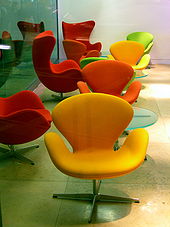 Arne Jacobsen's The Swan and the Egg
Arne Jacobsen's The Swan and the Egg Main article: Danish design
Main article: Danish designDanish applied art and industrial design have won many international awards. Georg Jensen (1866–1935) is noted for his modern design in silver. The Danish Porcelain Factory ("Royal Copenhagen") is famous for the quality of its ceramics and export products worldwide. Danish design is also a well-known brand, often associated with world-famous designers and architects such as Børge Mogensen, Poul Kjærholm, Hans Wegner, Poul Henningsen and Arne Jacobsen.[140]
The Danish Museum of Art & Design in Copenhagen exhibits the best in Danish design.
Literature
Main article: Danish literatureThe first known Danish literature is myths and folk stories from the 10th and 11th century. Saxo Grammaticus, normally considered the first Danish writer, worked for bishop Absalon on a chronicle of Danish history (Gesta Danorum). Very little is known of other Danish literature from the Middle Ages. With the Age of Enlightenment came Ludvig Holberg whose comedy plays are still being performed.
Romanticism influenced world famous writer Hans Christian Andersen known for his stories and fairy tales, e.g. The Ugly Duckling, and contemporary philosopher Søren Kierkegaard greatly influenced existentialism. In the late 19th century, literature was seen as a way to influence society. Known as the Modern Breakthrough, this movement was championed by Georg Brandes, Henrik Pontoppidan (awarded the Nobel Prize in Literature) and J. P. Jacobsen. In recent history Johannes Vilhelm Jensen was also awarded the Nobel Prize for Literature. Karen Blixen is famous for her novels and short stories. Other Danish writers of importance are Grundtvig, Gustav Wied, William Heinesen, Martin Andersen Nexø, Hans Scherfig, Tom Kristensen, Klaus Rifbjerg, Dan Turéll, Tove Ditlevsen, Inger Christensen and Peter Høeg.
Media
Danish media is dominated by a few large corporations. In printed media JP/Politikens Hus and Berlingske Media, between them, control the largest news papers Politiken, Berlingske Tidende and Jyllands Posten and major tabloids BT and Ekstrabladet. In television publicly owned stations Danmarks Radio (DR) and TV2 have large shares of the viewers. In radio DR has a near monopoly, currently broadcasting on all 4 nationally available FM channels, competing only with local stations. The share of Danish people that go online for news and entertainment is growing, however the newspapers and TV stations are still dominant.
Music
Main article: Music of DenmarkDenmark has long been a center of cultural innovation. Copenhagen and its multiple outlying islands have a wide range of folk traditions. The Royal Danish Orchestra is among the world's oldest orchestras. Carl Nielsen, with his six imposing symphonies, was the first Danish composer to gain international recognition, while an extensive recording industry has produced pop stars and a host of performers from a multitude of genres. Internationally only a few artists have gained significant success. Lars Ulrich from Metallica is from Denmark, along with Raveonettes, D-A-D, Volbeat, Mercyful Fate, Medina, Junior Senior, King Diamond, Goodiepal, Whigfield, Michael Learns to Rock, Alphabeat, Infernal, Oh Land, the 1990s pop band Aqua and the alternative rock bands Kashmir and Mew. In recent years, the best selling Danish artist abroad has been Rune RK with the number 1 iTunes hit[141] Calabria
Photography
Main article: Photography in DenmarkPioneers such as Mads Alstrup and Georg Emil Hansen paved the way for a rapidly growing profession during the last half of the 19th century while both artistic and press photographers have since made internationally recognised contributions. Today Astrid Kruse Jensen and Jacob Aue Sobol participate in key exhibitions around the world.[142]
Cuisine
 Danish open sandwich (smørrebrød) on dark rye bread
Danish open sandwich (smørrebrød) on dark rye bread Main article: Danish cuisine
Main article: Danish cuisineThe cuisine of Denmark, like that in the other Nordic countries as well as that of Northern Germany, consists mainly of meat and fish. This stems from the country's agricultural past, as well as its geography and climate of long, cold winters.
Danish food includes a variety of open rugbrød (Rye-bread) sandwiches or smørrebrød traditionally served for the mid-day meal or frokost (lunch). An ordinary frokost consists just of 2 to 6 pieces of simple smørrebrød prepared during breakfast and packed in a lunch box. A luxury frokost usually starts with fish such as pickled herring, smoked eel or hot fried plaice. Then come meat sandwiches such as cold roast beef with remoulade and fried onions, roast pork and crackling with red cabbage, hot veal medallions, Danish meat balls (frikadeller) or liver paté with bacon and mushrooms.
Some typically Danish items are Sol over Gudhjem, literally "sun over God's home" (Gudhjem is a town on Bornholm where a lot of herring is landed and smoked), consisting of smoked herring, chives and with raw egg yolk (the "sun") on top; or Dyrlægens natmad, 'vet's late-night bite', with liver paté, saltmeat (corned veal), sliced onions and jellied consommé. Finally cheese is served with crackers, radishes, or grapes. Lager beer accompanied by small glasses of snaps or aquavit are the preferred drinks for a Danish frokost. An other Danish meal is Danish Pastry. It is not made other places than Denmark. In Danish it is called 'Wienerbrød'.
 Æbleskiver, Small Danish dessert dumplings cooked in a special pan, mostly served during the Christmas season.
Æbleskiver, Small Danish dessert dumplings cooked in a special pan, mostly served during the Christmas season.
The large hot meal of the day is called middag and is usually served in the evening. It normally consists of meat (pork, beef, lamb or fish) with gravy and a source of starch (non-sugar carbohydrates) such as boiled potatoes, rice or pasta, sometimes supplemented by salad and/or cabbage. This may be followed by a dessert such as ice cream, mousse or rødgrød. The meal may be preceded by soup or hot porridge.
Popular meat dishes include pork steak with crispy skin, frikadeller (fried pork and veal meatballs), fried meat patties made from minced beef, beef tenderloin, "million-beef" (minced beef in gravy), karbonader/krebinetter (breaded and fried minced meat, typically pork), all kinds of roast etc. Popular combined meat and starch dishes include Spaghetti alla Bolognese, hash etc.
Fish is traditionally more widely eaten on the west coast of Jutland, where fishing is a major industry. Smoked fish dishes (herring, mackerel, eel) from local smoking houses or røgerier, especially on the island of Bornholm, are increasingly popular.
In recent years, Copenhagen restaurants like Noma, Geranium and MR has played an important role in re-inventing the Danish and Nordic cuisine, making Copenhagen a centre of gourmet dining with a Nordic twist.
Sports
Main article: Sports in DenmarkThe most popular sport in Denmark is football. Sailing and water sports are popular, as are golf, tennis, cycling and indoor sports such as badminton, handball and various forms of gymnastics. There is also a small group of people doing motorsport and with some success. In speedway racing Denmark has won several world championships. In 1992, the national football team won the European championship. The team finished second in their qualifying group behind Yugoslavia and as a result had failed to qualify for the final tournament. They gained their place in the tournament at the last moment when the Yugoslavia national team and local clubs were banned from all international/continental competitions because of the ongoing Yugoslav Wars. The Danes won the final by defeating reigning 1990 FIFA World Cup champions Germany 2-0 on goals by John Jensen and Kim Vilfort.
A number of smaller sports are also played in Denmark. E.g. the Danish Australian Football League is commonly known as the largest Australian Rules Football League outside the English-speaking world.[143] The national team; the Danish Vikings, became second in the first ever European Championship, losing the final to Ireland. Denmark was also co-hosts of the competition alongside Sweden.
Notable Danish sportspeople include:
- Tom Kristensen, the most successful driver on the 24 Hours of Le Mans race ever, with eight 1st places
- American football's National Football League all-time leading scorer Morten Andersen
- 12 times windsurfing world champion Björn Dunkerbeck
- Sailors Jesper Bank and Paul Elvstrøm one of only four persons ever to win four consecutive individual Olympic gold medals
- Cyclists Bjarne Riis winner of the 1996 Tour de France, Rolf Sørensen with 53 career wins, Jesper Skibby, Brian Holm, Ole Ritter, Henrik Djernis and Michael Rasmussen
- Speedway riders Hans Nielsen, Ole Olsen, Erik Gundersen and Nicki Pedersen all winners of several world championships.
- Badminton players Morten Frost, Erland Kops, Peter Gade, Poul-Erik Høyer Larsen, Flemming Delfs, Camilla Martin, Tine Baun and Lene Køppen
- Table tennis player Michael Maze
- Handball player Anja Andersen and Mikkel Hansen
- Poker Hall of Fame player Gus Hansen and Peter Eastgate
- Snowboarder Julie Wendel Lundholdt
- Skateboarder Rune Glifberg
- Football players Michael and Brian Laudrup, Preben Elkjær Larsen winner of the 1984–85 Serie A with Hellas Verona F.C. the club's first and only Scudetto, Allan Simonsen winner of the 1977 Ballon d'Or, Johnny Hansen European Cup winner in 1974, 1975 and 1976 with FC Bayern Munich and Peter Schmeichel winner of the 1999 treble with Manchester United, Daniel Agger who currently plays for Liverpool F.C., Nicklas Bendtner who plays for Sunderland A.F.C. and Anders Lindegaard who plays for Manchester United.
- Track and field athlete Wilson Kipketer who held the men's 800 metres world record until 22 August 2010;[144]
- Tennis player Caroline Wozniacki who on 11 October 2010 claimed the top spot in the WTA Singles Rankings.
- Former WBC Super middleweight boxing champion, Mikkel Kessler
- European tour golfer Thomas Bjørn, who has won nineteen professional tournaments. Of which thirteen were on the European Tour
- UFC Welterweight fighter Martin Kampmann
See also
- Outline of Denmark
- Index of Denmark-related articles
References
- ^ "Kongehuset" (in Danish). http://www.kongehuset.dk/publish.php?dogtag=k_dk_familien_dronningen. Retrieved 29 November 2010.
- ^ a b "Immigrants and their descendants and foreign nationals". Statistics Denmark. Dst.dk. 12 May 2010. http://www.dst.dk/HomeUK/Statistics/focus_on/focus_on_show.aspx?sci=565. Retrieved 31 July 2010.
- ^ "Population by region and time". Statistics Denmark. 1 April 2011. http://www.dst.dk/HomeUK/Statistics/Key_indicators/Population/pop.aspx. Retrieved 11 May 2011.
- ^ a b c d "Denmark". International Monetary Fund. http://www.imf.org/external/pubs/ft/weo/2011/01/weodata/weorept.aspx?pr.x=76&pr.y=12&sy=2008&ey=2011&scsm=1&ssd=1&sort=country&ds=.&br=1&c=128&s=NGDPD%2CNGDPDPC%2CPPPGDP%2CPPPPC%2CLP&grp=0&a=. Retrieved 21 April 2011.
- ^ "Human Development Report 2010". United Nations. 2010. http://hdr.undp.org/en/media/HDR_2010_EN_Table1.pdf. Retrieved 5 November 2010.
- ^ Esping-Andersen, G. (1990). The three worlds of welfare capitalism. Princeton, NJ: Princeton University Press.
- ^ "Gini Coefficient". Vision of Humanity.org. http://www.visionofhumanity.org/gpi-data/#/2010/GINI. Retrieved 23 January 2011.
- ^ Francesca Levy, "The World's Happiest Countries", Forbes 14 July 2010
- ^ Francesca Levy, "Table: The World's Happiest Countries", Forbes 14 July 2010
- ^ "Transparency International – the global coalition against corruption". Transparency.org. 15 December 2010. http://www.transparency.org/policy_research/surveys_indices/cpi/2010/results. Retrieved 2 June 2011.
- ^ Kristian Andersen Nyrup, Middelalderstudier Bog IX. Kong Gorms Saga
- ^ Indvandrerne i Danmarks historie, Bent Østergaard, Syddansk Universitetsforlag 2007, ISBN 978-87-7674-204-1, pp. 19–24
- ^ J. de Vries, Altnordisches etymologisches Wörterbuch, 1962, 73; N. Å. Nielsen, Dansk etymologisk ordbog, 1989, 85–96.
- ^ Navneforskning, Københavns Universitet Udvalgte stednavnes betydning.
- ^ "Danmark – Ordbog – ODS – ordnet.dk" (in Danish). http://ordnet.dk/ods/ordbog?query=Danmark. Retrieved 29 November 2010. "oldn. Danmǫrk"
- ^ The 'David' referred to here appears to be David, the ancient king of the Israelites: of course this is wildly anachronistic, but it is fairly typical of such sources, which commonly sought to push national or dynastic origins as far back as possible.
- ^ Thorpe, B., The Life of Alfred The Great Translated From The German of Dr. R. Pauli To Which Is Appended Alfred's Anglo-Saxon Version of Orosius, Bell, 1900, p. 253.
- ^ The dative form tąnmarku (pronounced [danmarkʊ]) is found on the contemporaneous Skivum stone.
- ^ Michaelsen (2002), p. 19.
- ^ a b Nielsen, Poul Otto (May 2003). "Denmark: History, Prehistory". Royal Danish Ministry of Foreign Affairs. Archived from the original on 22 November 2005. http://web.archive.org/web/20051122020555/http://www.um.dk/Publikationer/UM/English/Denmark/kap6/6-1.asp. Retrieved 1 May 2006.
- ^ Busck and Poulsen (ed.) (2002), p. 20.
- ^ Jordanes; translated by Charles C. Mierow (22 April 1997). "The Origin and Deeds of the Goths, chapter III". http://www.acs.ucalgary.ca/~vandersp/Courses/texts/jordgeti.html#III. Retrieved 1 May 2006.
- ^ Busck and Poulsen (ed.) (2002), p. 19.
- ^ a b Michaelsen (2002), pp. 122–23.
- ^ Staff. Saint Brices Day massacre, Encyclopædia Britannica. Retrieved 26 December 2007.
- ^ Palle Lauring, A History of the Kingdom of Denmark (Host & Son Co.: Copenhagen, 1960) p. 108.
- ^ a b Lauring
- ^ Lauring, pp. 139–141.
- ^ Lauring, pp. 140–141.
- ^ Lauring, pp. 142–143.
- ^ Taylor, A.W.
 Catholic Encyclopedia (1913): Ancient See of Viborg in Denmark. Wikisource.
Catholic Encyclopedia (1913): Ancient See of Viborg in Denmark. Wikisource. - ^ Robert S. Hoyt & Stanley Chodorow, Europe in the Middle Ages (Harcourt, Brace & Jovanovich, Inc.: New York, 1976) p. 643.
- ^ Hoyt
- ^ Thirty Year's War edited by Geoffrey Parker (Routledge Pub.: London, 1997) p. 65.
- ^ Lauring, p. 106.
- ^ Parker, p. 64.
- ^ "Kalmarkriget 1611–1613". Svenskt Militärhistoriskt Bibliotek. Archived from the original on 11 October 2007. http://web.archive.org/web/20071011111014/http://smb.nu/svenskakrig/1611.asp. Retrieved 4 May 2007.
- ^ Parker, pp. 69–70.
- ^ Parker, p. 70.
- ^ Geoffrey Parker (2001). "Europe in crisis, 1598–1648". Wiley-Blackwell. p.205. ISBN 0631220283
- ^ Hendriksen, C. Næsh (ed.) (1945) (in Danish). Den danske Kamp i Billeder og Ord. Odense: Bogforlaget "Dana". p. 18. Photo taken near Bredevad in Southern Jutland.
- ^ "Landet i tal – Største øer". National Survey and Cadastre of Denmark. 23 September 2003. http://www2.kms.dk/C1256AED004EA666/(AllDocsByDocId)/1D7EE8822587E667C1256AEF0030ABF6?open&page=strste&omr=KORT_DK_I_TAL. Retrieved 14 July 2007.
- ^ Statistikbanken.dk/bef4
- ^ Dahlgaard, Jørgen. "Danmarks nye top" (PDF). Aktuel Naturvidenskab 2005 (1): 2. Archived from the original on 7 March 2008. http://web.archive.org/web/20080307040437/http://www.aktuelnat.au.dk/pdf05_1/an1top.pdf. Retrieved 3 February 2007.
- ^ "Nature & Environment". Denmark.dk. Archived from the original on 3 April 2007. http://web.archive.org/web/20070403235436/http://denmark.dk/portal/page?_pageid=374,520337&_dad=portal&_schema=PORTAL. Retrieved 3 February 2007.
- ^ Nationalencyklopedin, (1990)
- ^ a b "Climate Normals for Denmark". Danish Meteorological Institute. http://www.dmi.dk/dmi/index/danmark/oversigter/klimanormaler.htm. Retrieved 28 October 2008. Figures, labeled in Danish: First plot is the whole country; Nedbør=Precipitation, Nedbørdage=Precipitation days (>1 mm), (Dag/Middel/Nat)temp.=(Daytime/Average/Nighttime) temperature, Solskinstimer=Hours of sunshine.
- ^ "Copenhagen, Denmark – Sunrise, sunset, dawn and dusk times for the whole year". Gaisma. http://www.gaisma.com/en/location/kobenhavn.html. Retrieved 2 May 2006.
- ^ Store Danske Encyklopædi (2004), CD-ROM edition, entry Sankthansaften
- ^ Store Danske Encyklopædi (2004), CD-ROM edition, entry Majskikke.
- ^ a b "Denmark". The World Factbook. CIA. 23 January 2008. https://www.cia.gov/library/publications/the-world-factbook/geos/da.html. Retrieved 3 February 2007.
- ^ Kahn, Matthew E.. "Living Green: Full Country and City Rankings: Countries Overall | Your America | Reader's Digest". Rd.com. http://www.rd.com/your-america-inspiring-people-and-stories/best-places-to-live-green/article45734.html. Retrieved 5 May 2009.[dead link]
- ^ "15 green cities". grist. http://www.grist.org/article/cities3/. Retrieved 5 January 2009.
- ^ "Copenhagen Receives European Environmental Award". grist. http://www.dhigroup.com/News/NewsArchive/2006/CopenhagenReceivesEuropeanEnvironmentalAward.aspx. Retrieved 5 January 2009.
- ^ "The win-win ways of Cleantech business". CBS Observer. 26 March 2009. http://cbsobserver.dk/win-win-ways-cleantech-business. Retrieved 24 July 2009.
- ^ "Denmark – Wolfram Alpha". 2.wolframalpha.com. http://www02.wolframalpha.com/input/?i=denmark+green+house+gas+emission+per+denmark+gdp. Retrieved 20 August 2009.
- ^ "Germany – Wolfram Alpha". 2.wolframalpha.com. http://www02.wolframalpha.com/input/?i=Germany+green+house+gas+emission+per+Germany+gdp. Retrieved 20 August 2009.
- ^ "Norway – Wolfram Alpha". 3.wolframalpha.com. http://www03.wolframalpha.com/input/?i=norway+green+house+gas+emission+per+norway+GDP. Retrieved 20 August 2009.
- ^ "Sweden – Wolfram Alpha". 3.wolframalpha.com. http://www03.wolframalpha.com/input/?i=Sweden+green+house+gas+emission+per+Sweden+GDP. Retrieved 8 July 2009.
- ^ Michael Kjær, Jonas (15 November 2006). "Christiansø betaler ikke sundhedsbidrag". dr.dk. http://www.dr.dk/Regioner/Bornholm/Nyheder/Christiansoe/2006/11/15160130.htm. Retrieved 12 August 2007.(Danish)
- ^ Gammelgaard & Sørensen 1998, p. 36.
- ^ Gammelgaard & Sørensen 1998, p. 18.
- ^ Jørgensen 1995, p. 16.
- ^ "Radikale ved historisk skillevej". Berlingske Tidende. 17 June 2007. http://www.berlingske.dk/article/20070617/dineord/106171178/. Retrieved 17 August 2007.
- ^ Danish embassy in Tallinn, Estonia. "Danish – Estonian Defence Cooperation". http://www.ambtallinn.um.dk/en/menu/TheEmbassy/DanishEstonianDefenceCooperation/DanishEstonianDefenceCooperation.htm. Retrieved 22 February 2011.
- ^ Danish embassy in Riga, Latvia. "Danish – Latvian Defence Cooperation". http://www.ambriga.um.dk/da/menu/Forsvarssamarbejde/. Retrieved 22 February 2011.
- ^ "Forsvarsministerens Verdenskort". Web.archive.org. 27 December 2007. Archived from the original on 27 December 2007. http://web.archive.org/web/20071227125607/http://forsvaret.dk/FMN/Verdenskort/. Retrieved 20 August 2009.
- ^ "Denmark follows UK Iraq pullout". Al Jazeera English. 21 February 2007. http://english.aljazeera.net/news/middleeast/2007/02/200852514261678446.html. Retrieved 20 August 2009.
- ^ UNDP.org[dead link] Human Development Report 2007/2008
- ^ List of countries by Human Development IndexList of countries by Human Development Index
- ^ UNESCO 2009 Global Education Digest, Shared fourth with Finland at a 30.3% ratio. Graph on p28, table on p194.
- ^ Harmonised unemployment rate by gender Totals Eurostat
- ^ "In the Media". Investindk.com. http://www.investindk.com/visArtikel.asp?artikelID=14338. Retrieved 5 May 2009.
- ^ Business Environment, Invest in Denmark
- ^ "Skattetrykket". Danish Ministry of Taxation. http://www.skm.dk/tal_statistik/skatter_og_afgifter/510.html.
- ^ "Denmark and the euro". Danmarks Nationalbank. 17 November 2006. http://www.nationalbanken.dk/DNUK/Euro.nsf/side/Denmark_and_the_euro!OpenDocument. Retrieved 3 February 2007.
- ^ "Denmark to have second referendum on euro". 22 November 2007. http://euobserver.com/9/25202. Retrieved 22 November 2007.
- ^ Why Denmark Loves Globalisation, Time Magazine
- ^ Danish Exporters (2008). "Danish Export-Import – Denmark’s International Trade and Main Export Markets". Danish Exporters. http://www.danishexporters.dk/scripts/danishexporters/export.asp. Retrieved 29 October 2009.[dead link]
- ^ "Statens Gæld og Låntagning". Statistics Denmark. http://www.dSt.dk/aarbogstabel/407.
- ^ Miller, John (4 January 2005). "John Miller, at Dollars & Sense". Dollarsandsense.org. http://www.dollarsandsense.org/archives/2005/0305miller.html. Retrieved 20 August 2009.
- ^ "Comparisons of Index of Economic Freedom with GDP/capita". Leftbusinessobserver.com. 26 March 2005. http://www.leftbusinessobserver.com/FreedomIndex.html. Retrieved 20 August 2009.
- ^ Miller, John (4 January 2005). "John Miller at Dollars & Sense". Dollarsandsense.org. http://www.dollarsandsense.org/archives/2005/0305miller.html. Retrieved 20 August 2009.
- ^ "EIA – International Energy Data and Analysis for Denmark". Tonto.eia.doe.gov. 15 May 2009. http://tonto.eia.doe.gov/country/country_energy_data.cfm?fips=DA. Retrieved 29 May 2009.
- ^ from www.ens.dk
- ^ Rank-1 in Clean Energy[dead link]
- ^ "Tyske miljøzoner sender gamle biler til Danmark" (in Danish). Politiken.dk. 9 January 2009. http://politiken.dk/indland/ECE626918/tyske-miljoezoner-sender-gamle-biler-til-danmark/. Retrieved 29 November 2010.
- ^ "Cykelruter og regioner" (in Danish). Visitdenmark.com. http://www.visitdenmark.dk/danmark/da-dk/menu/turist/inspiration/aktivferie/cykel/cykel-ruter-og-regioner.htm. Retrieved 16 August 2011.
- ^ "Vi cykler til arbejde 2011" (in Danish). Dansk Cyklist Forbund. http://www.vcta.dk/OmVCTA.aspx. Retrieved 16 August 2011.
- ^ "Plug-in and Electrical Vehicles". EnergyMap.dk. http://www.energymap.dk/Technology-Areas/Intelligent-Energy/Plug-in-and-Electrical-Vehicles. Retrieved 10 October 2009.[dead link]
- ^ "The Future High-Efficiency Electric Car, Integrated into the Electricity Supply Network". EnergyMap.dk. http://www.energymap.dk/Profiles/Department-of-Energy-Technology-Aalborg-University/Projects/The-Future-High-Efficiency-Electric-Car--Integrate. Retrieved 10 October 2009.[dead link]
- ^ "LO's ugebrev/2008". Ugebreveta4.dk. http://www.ugebreveta4.dk/2008/200826/Baggrundoganalyse/LoenmodtagereKlarTilNyeDagpengeregler.aspx. Retrieved 20 August 2009.
- ^ "Ledigheden faldt til 2,7 pct." (PDF). Statistics Denmark. http://www.dst.dk/pukora/epub/Nyt/2008/NR031.pdf. Retrieved 24 July 2009.
- ^ DST.dk[dead link], Beskæftigelsesindikator på grundlag af ATP-indbetalinger. In June 2008 unemployment hit a new low of only 1.6%. This rate has been dropping continuously since December 2003, when 170,700 were unemployed.
- ^ Madsen, Bjarne; Svend Lundtorp (2006). Arbejdsmarkedet på Sjælland og øerne i 2015. Akf forlaget. p. 10. ISBN 87-7509-801-6. http://www.akf.dk/udgivelser/2006/pdf/arbejdsmarkedet_sjaelland_oeer.pdf/. Retrieved 3 February 2007.
- ^ Statistikbanken.dk, tables AB513+ BESK11+12+13.
- ^ Nüchel, Jens; Lars Erik Skovgaard (13 December 2006). "Danskere arbejder mere og mere". Business.dk (Berlingske Tidende). Archived from the original on 11 October 2007. http://web.archive.org/web/20071011104002/http://www.business.dk/karriere/artikel:aid=2014652. Retrieved 3 February 2007.
- ^ Bonde, Annette (24 September 2007). "Virksomheder foretrækker tysk arbejdskraft". Business.dk (Berlingske Tidende). http://www.business.dk/article/20070923/karriere/109231065/. Retrieved 23 September 2007.
- ^ "Udlændinge passer hvert 10. job" (in (Danish)). Politiken.dk. 19 June 2009. http://politiken.dk/erhverv/article441694.ece. Retrieved 20 August 2009.
- ^ Af Eva Jung. "Arbejdsmarkedets most wanted (11. August 2008)". Business.dk. http://www.business.dk/article/20080811/brancher/80811082/. Retrieved 29 April 2010.
- ^ "Danish Economic Council Spring Report 2008 English Summary,p. 11". Dors.dk. http://www.dors.dk/sw5855.asp. Retrieved 20 August 2009.
- ^ "Skattesatser; bundgrænser, procenter og fradrag". Skat.dk. http://www.skat.dk/SKAT.aspx?oId=133800. Retrieved 29 April 2010.
- ^ "Kommuneskatter 2007, 2008 og 2009". Skm.dk. http://www.skm.dk/tal_statistik/kommuneskatter/procenter/?year=2009. Retrieved 29 April 2010.
- ^ "Registration tax for cars". Skatteministeriet. 24 March 2008. Archived from the original on 27 September 2007. http://web.archive.org/web/20070927035651/http://www.skm.dk/foreign/english/taxindenmark2007/5344/#104.
- ^ "Danes' Anti-Immigrant Backlash Marks Radical Shift". http://www.npr.org/templates/story/story.php?storyId=6505809. Retrieved 28 January 2007.
- ^ "Denmark gets tough on immigrants". BBC News. 27 November 2001. http://news.bbc.co.uk/2/hi/europe/1679235.stm. Retrieved 2 January 2010.
- ^ "Tal og fakta på udlændingeområdet" (PDF). http://www.nyidanmark.dk/NR/rdonlyres/01D113D6-EA0D-4DB6-B2F9-DA47A6706EFF/0/tal_og_fakta_2006.pdf. Retrieved 20 August 2009.
- ^ (Danish) Nyt fra Danmarks Statistik
- ^ Taylor, Jerome (1 August 2006). "Denmark is the world's happiest country – official – Europe, World". The Independent (London). http://www.independent.co.uk/news/world/europe/denmark-is-the-worlds-happiest-country--official-410075.html. Retrieved 5 May 2009.
- ^ "U.S. Census". U.S. Census Bureau. http://factfinder.census.gov/servlet/ADPTable?_bm=y&-geo_id=01000US&-ds_name=ACS_2006_EST_G00_&-_lang=en&-_caller=geoselect&-format=.
- ^ "Ethnocultural Portrait of Canada Highlight Tables, 2006 Census". 2.statcan.ca. 2 April 2008. http://www12.statcan.ca/english/census06/data/highlights/ethnic/pages/Page.cfm?Lang=E&Geo=PR&Code=01&Data=Count&Table=2&StartRec=1&Sort=3&Display=All&CSDFilter=5000. Retrieved 20 August 2009.
- ^ (Danish)Statistics 1984 – 2002 by the Kirkeministeriet
- ^ (Danish)Statistics 1990 – 2009 Kirkeministeriet
- ^ (Danish) Statistics 2010
- ^ (Danish) Membership Lutheran state church
- ^ Religion in Denmark[dead link] – From the Danish Foreign Ministry.
- ^ "Eurobarometer on Social Values, Science and technology 2005 – page 11" (PDF). http://ec.europa.eu/public_opinion/archives/ebs/ebs_225_report_en.pdf. Retrieved 5 May 2007.
- ^ Zuckerman, Phil. "The Largest Atheist / Agnostic Populations". http://www.adherents.com/largecom/com_atheist.html.
- ^ Martin (ed.), Michael (2005). "Atheism: Contemporary Rates and Patterns". The Cambridge Companion to Atheism. Cambridge: Cambridge University Press.
- ^ Torben Sørensen (19 April 2007). "Forn Siðr – the Asa and Vane faith religious community in Denmark – Forn Siðr". Fornsidr.dk. http://www.fornsidr.dk/dk/17. Retrieved 5 May 2009.
- ^ Range of rank on the PISA 2006 science scale. [www.oecd.org OECD]. http://www.oecd.org/dataoecd/42/8/39700724.pdf. Retrieved 22 January 2010.
- ^ "The Official Website of the Nobel Prize". http://nobelprize.org/nobel_prizes/nobelprize_facts.html/.
- ^ "Study in Denmark, official government website on international higher education in Denmark". http://studyindenmark.dk/.
- ^ "The Danish Folkehøjskole". scandinavica.com. http://www.scandinavica.com/culture/education/hojskole.htm. Retrieved 28 January 2007.
- ^ "Copenhagen Walking Tours". 25 May 2007. http://www.copenhagen-walkingtours.dk/. Retrieved 25 May 2007.
- ^ "Copenhagen". http://www.monocle.com/sections/edits/Web-Articles/Copenhagen/. Retrieved 22 July 2011.
- ^ "Denmark – An Overview". 22 September 2007. Archived from the original on 22 January 2008. http://web.archive.org/web/20080122084309/http://www.um.dk/publikationer/um/english/factsheetdenmark/denmarkanoverview/html/chapter05.htm. Retrieved 22 September 2007.
- ^ "Same-Sex Marriage FAQ". Marriage.about.com. 17 June 2003. http://marriage.about.com/cs/samesexmarriage/a/samesex.htm. Retrieved 5 May 2009.
- ^ "Danish Architecture: An Overview", Visit Denmark. Retrieved 3 September 2011.
- ^ "Architecture", Embassy of Denmark, Hanoi. Retrieved 3 October 2011.
- ^ Wall Paintings in Danish Churches from Panoramas.dk. Retrieved 12 August 2009. Adopting the Biblia pauperum approach, they present many of the most popular stories from the Old and New Testaments.
- ^ "Guide to the Danish Golden Age". Retrieved 4 September 2011.
- ^ Art Encyclopedia: Skagen. Retrieved 9 December 2008.
- ^ "The Funish Art Colony", Johannes Larsen Museet. Retrieved 12 August 2011.
- ^ The Bornholm School from the Rough Guide to Denmark. Retrieved 10 December 2008.
- ^ "Per Kirkeby exhibition", Tate Modern. Retrieved 4 March 2010.
- ^ ""Tal R: The Sum", Camden Arts Gallery". Camdenartscentre.org. http://www.camdenartscentre.org/exhibitions/?id=100436. Retrieved 2011-10-31.
- ^ Take Your Time. Olafur Eliasson. From MoMA. Retrieved 27 January 2010.
- ^ "Exhibition of Interactive Work by Artist Jeppe Hein Announced in Indianapolis", Artdaily.org. Retrieved 4 March 2010.
- ^ "Danish by Design", DDC. Retrieved 4 September 2011.
- ^ "Number one on itunes 2008". Enurmusic.com. 9 December 2008. http://www.enurmusic.com/number-1-on-itunes-2008/. Retrieved 6 February 2011.
- ^ Contemporary Danish Photography. From Photography-Now. Retrieved 28 January 2010.
- ^ "Danish Australian Football League". AFL.com.au. http://www.afl.com.au/denmark/tabid/10339/default.aspx. Retrieved 1 April 2011. "With over 260 seniors and 100 juniors participating annually, DAFL is by far the largest Australian football competition outside the English speaking world."
- ^ "Kenyan Rudisha breaks men's 800m world record". Reuters. 22 August 2010. http://in.reuters.com/article/idINIndia-50996520100822.
- Bibliography
- (Danish) Busck, Steen and Poulsen, Henning (ed.), "Danmarks historie – i grundtræk", Aarhus Universitetsforlag, 2002, ISBN 87-7288-941-1
- (Danish) Gammelgaard, Frederik; Sørensen, Niels (1998). Danmark – en demokratisk stat. Alinea. ISBN 87-23-00280-8.
- (Danish) Jørgensen, Gitte (1995). Sådan styres Danmark. Flachs. ISBN 87-7826-031-0.
- (Danish) Michaelsen, Karsten Kjer, "Politikens bog om Danmarks oldtid", Politikens Forlag (1. bogklubudgave), 2002, ISBN 87-00-69328-6
- (Swedish) Nationalencyklopedin, vol. 4, Bokförlaget Bra Böcker, 2000, ISBN 91-7024-619-X.
External links
- Government
- Official Portal of Denmark
- Study in Denmark – Official government website on international higher education in Denmark has a comprehensive list of higher education programmes and institutions in Denmark
- Denmark entry at The World Factbook
- Chief of State and Cabinet Members
- General information
- List of Danish Companies
- Danish Culture
- Facts about Denmark and a brief tour through the country
- Denmark entry at Encyclopædia Britannica
- Denmark at UCB Libraries GovPubs
- Denmark at the Open Directory Project
- Wikimedia Atlas of Denmark
- Denmark travel guide from Wikitravel
- DanishHeritage.dk exists to protect and promote Denmark's historic environment and ensure that its past is researched and understood
- News and media
- Google news Denmark
- History of Denmark: Primary Documents
- Krak printable mapsearch (Danish)
- Ministry of the Environment National Survey and Cadastre (Swedish) (English)
- Old Denmark in Cyberspace – Information about Denmark – the Danes
- Satellite image of Denmark at the NASA Earth Observatory
- Statistics Denmark Statistics free of charge
- Summary vital statistics about Denmark covering 1901 and forwards from Statistics Denmark
- Newest releases from Statistics Denmark (Danish) (English)
- Various statistics from Statistics Denmark statistikbanken.dk
- Other
- Vifanord.de – a digital library that provides scientific information on the Nordic and Baltic countries as well as the Baltic region as a whole

 Norway • Skagerrak
Norway • Skagerrak Norway • Skagerrak
Norway • Skagerrak Sweden • Kattegat
Sweden • Kattegat
 Great Britain • North Sea
Great Britain • North Sea
 Sweden • Øresund
Sweden • Øresund
 Denmark
Denmark 

 Netherlands • North Sea •
Netherlands • North Sea •  Germany
Germany Germany
Germany Germany •
Germany •  Poland • Baltic Sea
Poland • Baltic SeaCoordinates: 56°N 10°E / 56°N 10°E
Categories:- Denmark
- Constitutional monarchies
- Countries bordering the Atlantic Ocean
- Countries bordering the Baltic Sea
- Danish-speaking countries
- European countries
- Liberal democracies
- Member states of NATO
- Member states of the European Union
- Member states of the Union for the Mediterranean
- Member states of the United Nations
- Nordic countries
- Northern Europe
- NUTS 2 statistical regions of the European Union
- Scandinavia
- States and territories established in 1814
-
Wikimedia Foundation. 2010.

![Location of Denmark (dark green)– in Europe (green & dark grey)– in the European Union (green) — [Legend]](/pictures/enwiki/50/250px-EU-Denmark.svg.png)
